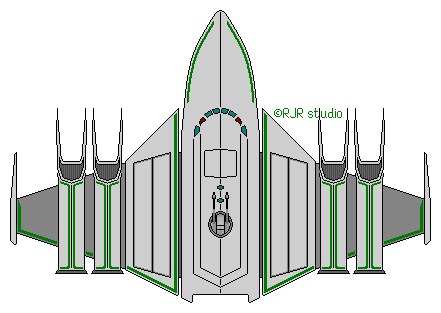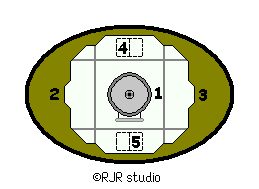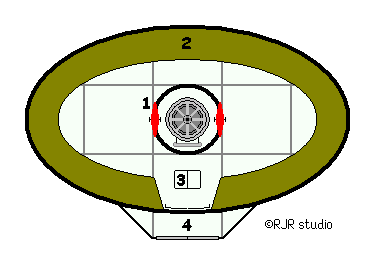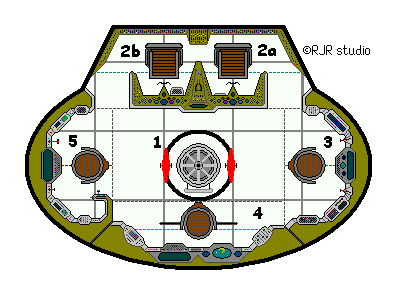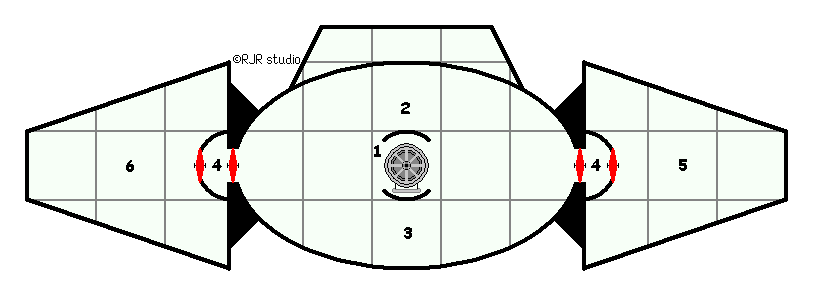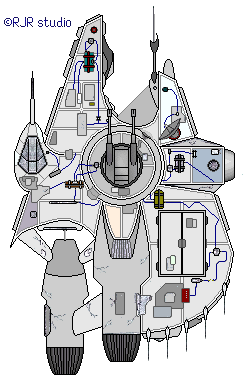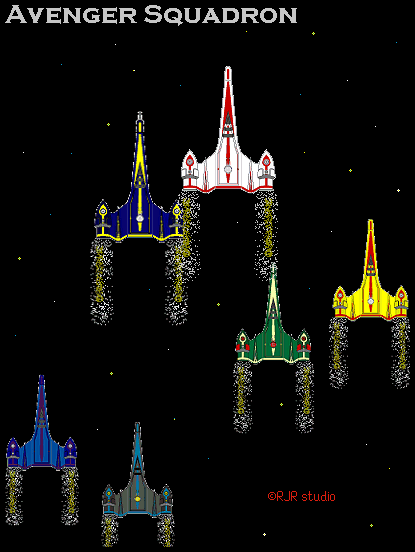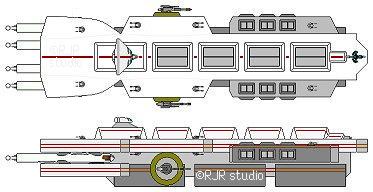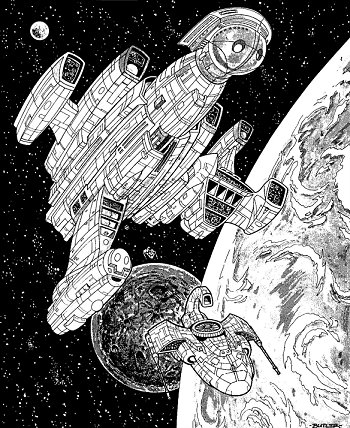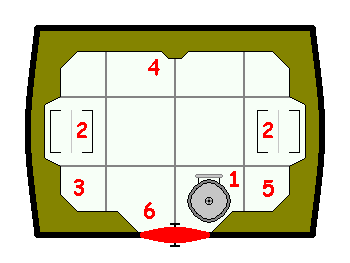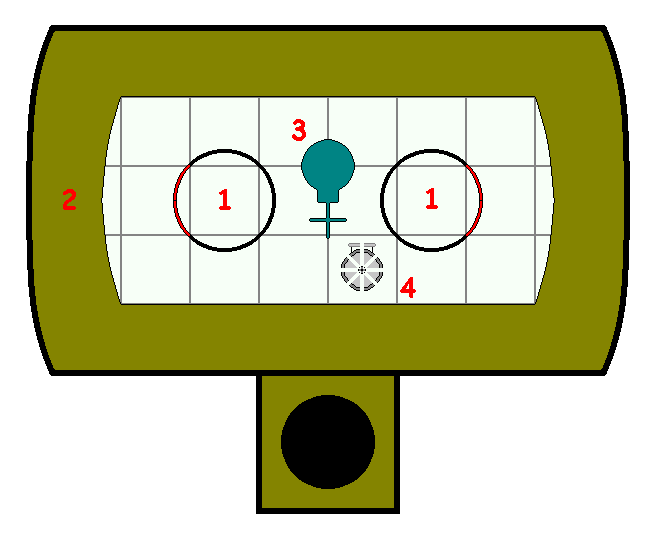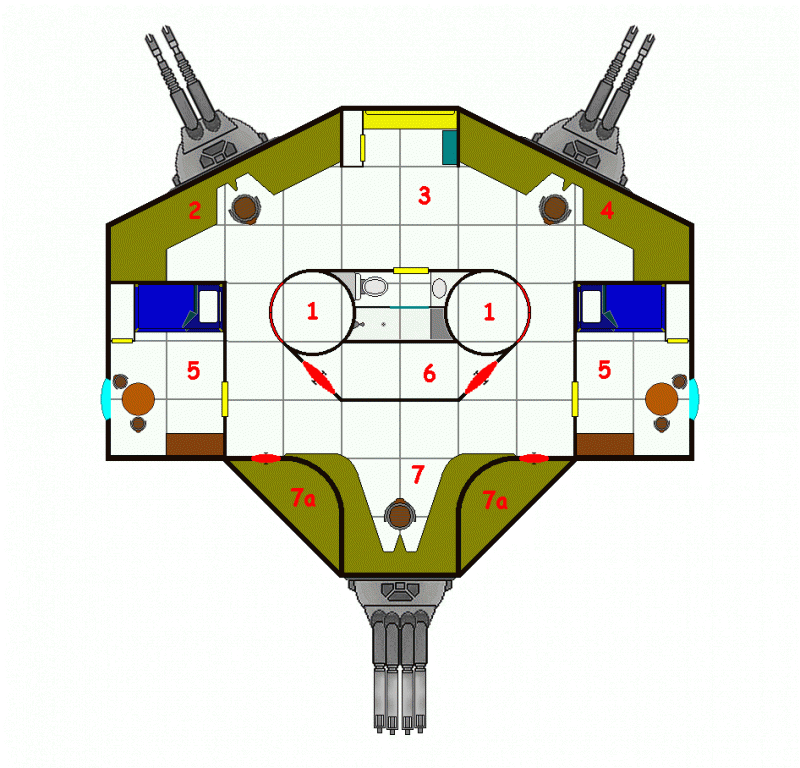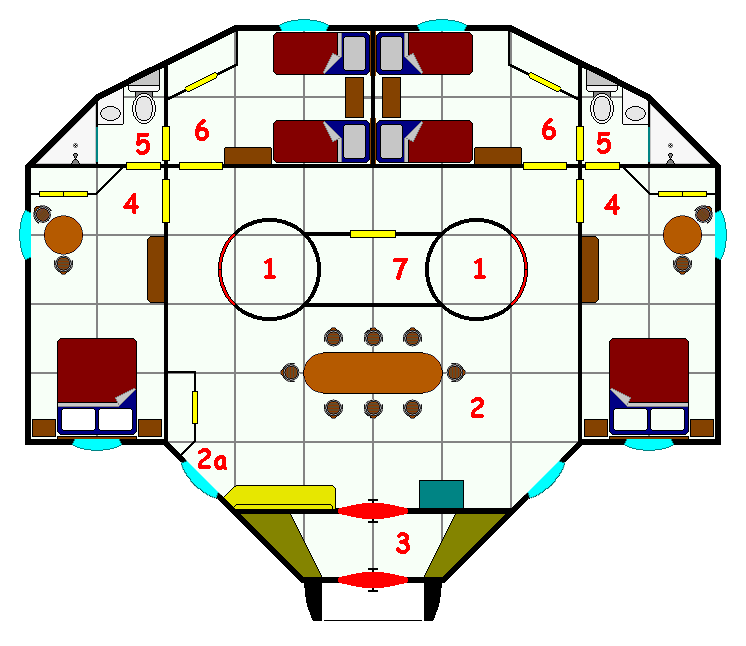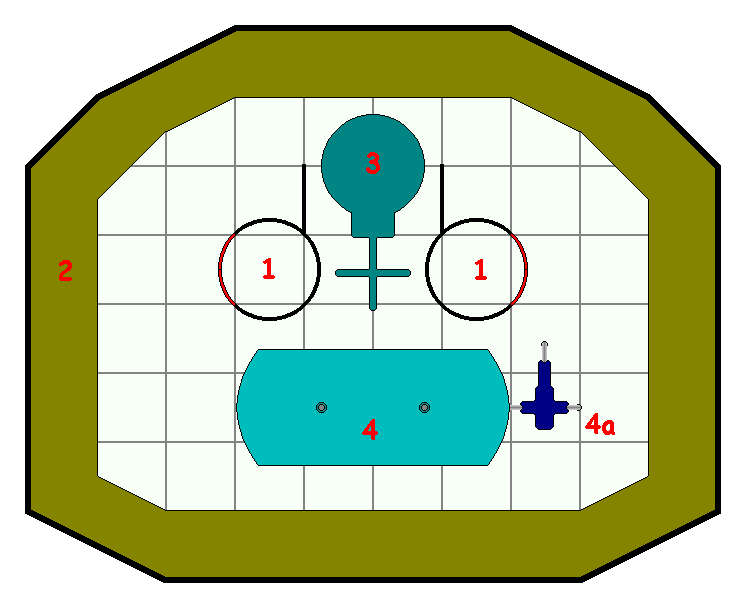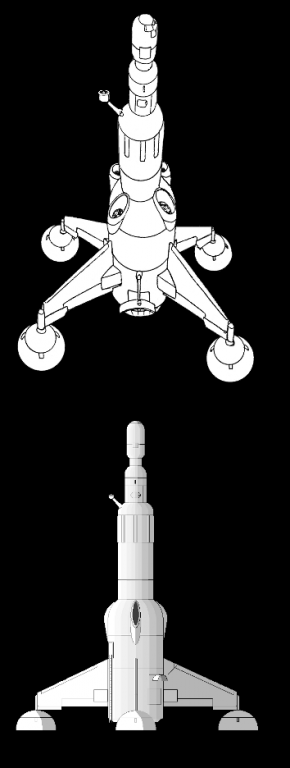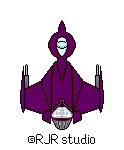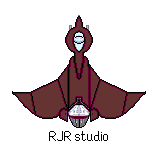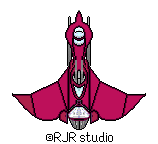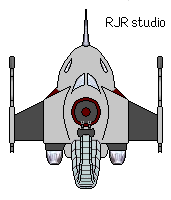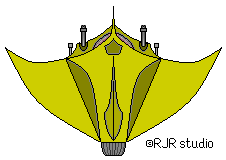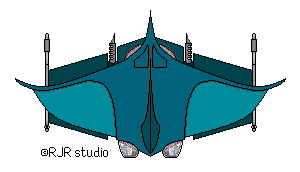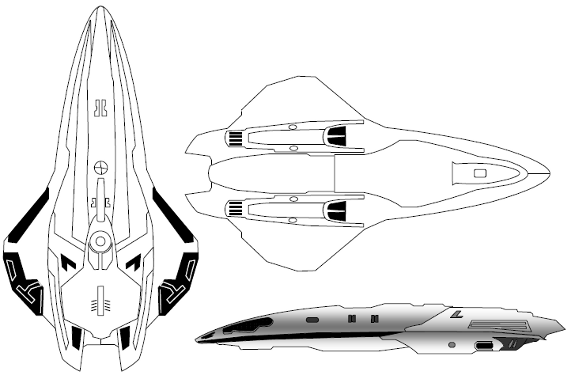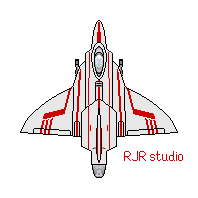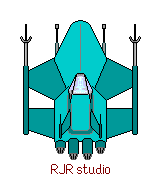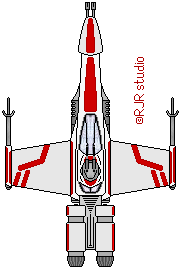Online Ship Generator
Document container for project design documents.
Akyna class light freighter
(submitted by Shadow Shack)
PGCF-425 Akyna class light freighter
HS:4 HP:24 Powerplant:4 atomic A
ADF:4 MR:4 DCR:32 crew: up to 8
Armament: two pod laser turrets
Defenses:RH
Communication/Detection:SubSpace Radio, Radar, Intercom (2 master panels, 13 speaker/mikes)
Misc:light armor, streamlined
Computer
LVL:4 fp:115 SP:100
Alarm(4), Analysis(4), Astrogation(4), Commerce (1), Communication (1), Damage Control (4), Drive - Atomic A (4), Industry (1), Laser Battery (1)x2, Life Support, cap:8 (1), Maintenance (4)
Cargo Capacity:3 (two 1.5u bays)
Crew Accomodations:4 double bunk cabins
Passenger Accomodations: 0
Ship's Vehicles:none
Base Price: 1,821,730 (does not include fuel, spacesuits, or toolkits)
The Akyna (the word is Russian for shark) is a versatile freight hauler that many an adventurer has a lustful eye for. And for good reason, the ship is small enough for most able crews to operate in a wide variety of situations, fairly well armed and armored boasting the lighter grade hull armor along with a pair of pod laser turrets, and a readily expandable mainframe computer (with additional space allotted for the hardware makes future upgrades quick and easy to install).
The hull is streamlined, and all bridge and engineering deck stations are situated on rotating deck gimbals allowing them to pivot to a "main axis parallel" stance for atmospheric use. The 3-unit cargo space doesn't allow for large profits, but crews can charge a little extra for promptness in delivery (along with the insurance via two laser turrets that the load will get there).
There are drawbacks to the basic design though. With no workpods, any external work will have to be performed via spacesuits, along with the wing mounted aft maneuver jet banks. As such, most populated worlds do not permit atomic drive overhaul procedures to occur in their breathable atmospheres. The craft may land and lift off at the local starport, and even perform routine maintenance...but once the reactor is exposed to the air, crews can expect a prompt visit from Star law and a resulting stiff fine and impound/quarantine fees to boot.
The twin cargo holds are another anamoly. They are tiered for ease in loading, but are situated for space duty. This means any ground based cargo acquisitions will take extra time to load (figure double the usual time). The ventral turret must also be positioned correctly for any landing (space station or starport), as the ground clearance is minimal with the landing gear. That said, atmospheric landings in rough or uneven terrain can cause damage to the ventral guns.
Also note the lack of emergency vehicles. No lifeboat, escape pods, or workpods means any attempt of escape would have to be executed in a launch (or simply leaping from an airlock), which is not included with the initial purchase although the craft is outfitted for accomodating one. The two crew decks do not offer much privacy, so being friendly is a must. And despite new technology in the drives and other systems, the main artery between decks is a standard ladderwell with airtight hatches on each deck. The upside to this is during atmospheric groundings, characters may easily walk between decks. All hatches are designed to open towards the ventral side so there is no hampering on opening hatches, although it may take a little extra effort to close them once opened.
Finally, the aft outer hull hatch is not easily defended when it comes to boarders. Two crew members can each find solace within the hold airlock hatchways for hard cover, as well as two more positioned behind the hatch bulkhead curtains, but incoming baddies will also benefit from hard cover until they fully emerge from below. Lobbing grenades is the best bet for repelling intruders here. Most owners station a few robots here to meet this end.
Customizing is an immediate option most owners perform. A ground vehicle ramp/hatch is easily installed on the forward hold, enabling a ground transport or explorer to be quickly dispatched once on the ground. The vehicle must be tethered and secured on the ramp/hatch and against the deck prior to liftoff, lest acceleration turns it into a huge lethal pinball. A Universal Docking Collar is easily affixed to the aft airlock, thus allowing one additional level of security measure for would be boarders that opt for standard entry. Upgunning an additional 20 cubic meters worth of weaponry can be performed as well at a -1 ADF or MR penalty, either by adding a forward firing pod laser system or upgrading to full on laser batteries.
Deckplans follow
Akyna DECK:0 --- Avionics
Akyna DECK:1 --- Forward Maneuver Banks
Akyna DECK:3 --- Forward Hold
Akyna DECK:4 --- Crew Decks (x2, decks 4 & 5)
Akyna DECK:6 --- Gunnery Deck
Akyna DECK:7 --- Engineering
Akyna DECK:8 --- Loading Deck
Aquilian Starling
(submitted by Shadow Shack)
This is the first SF starship I created, originally utilizing house rules I had penned nearly a year before Knight Hawks debuted. My original characters used it as such, eventually replacing it with another model dubbed the Volturnian Knighthawk. Imagine my surprise after creating that ship to walk into a department store and finding a Star Frontiers boxed set sporting the same name...anyways here's that original ship of mine in its current guise. I will someday convert it over to "decks perpendicular to main axis" but for now here she is in all her glory.
SS Aquilian Starling civilian light freighter
HS: 3* HP: 20 (-3) Powerplant: 3 Atomic A
ADF: 5 MR: 3 DCR: 40 Crew: up to 9
Armament: LB (x2)
Defenses: RH
Communication/Detection: SubSpace Radio, Radar, Energy Sensor, Intercom
Misc Equipment: Skin Sensor, Delux Astro, Camera System, Cybernetic Uplink Slave Circuits
Computer
(LVL: 4 fp: 198 sp:100)
Alarm (3), Analysis (6), Astrogation (4), Bureaucracy (5), Commerce (1), Communication (4), Computer Lockout (6), Computer Security (6), Cyber-link (3), Damage Control (3), Drive (4), Information Storage (3), Installation Security (6), Language (6), Laser Battery (1) x2, Life Support - cap:9 (1) x2, Maintenance (3), Robot Management (6)
Cargo Capacity: 3 (1.2 main hold, 1.8 aft hold)
Fuel Tankage: 6 uranium pellets, 3/drive
Crew Accomodations: 1 double cabin, 1 six-bunk cabin, 1 bunk in rec area
Passenger Accomodations: n/a
Ship's Vehicles: 0
* Actual displacement is HS:3, vessel was reduced by damage/reconstruction from original HS:4
Crew: Richard Sterling (mH) Pilot:3, Engineer:3, "Glasya" Carolina Sterling (cybernetic fH) Pilot:2, Astrogator:2, Engineer:1, Energy Gunner:4 --- Glasya may multi-task via the cyberlink connections, thus operating both battery weapons simultaneously as well as performing co-pilot & astrogator operations and coordinating engineer functions.
The Starling has a rich history, dating back before the founding of the UPF. A young Captain Knightrazor acquired it upon graduation from Gollwin Acadamy, and sold it after nearly ten years of freight hauling in favor of subcontracting a new RT model. The current owner, adventurer Richard Sterling, bought it from Knightrazor and still owns and operates it today. Sadly, the ship required major renovations after a near fatal encounter during the Second Sathar War. The ill-fated vessel unknowingly dropped out of the void into a UPF system that the Sathar Battle Fleet had already entered, and the ship took a beating. It would have no doubt been destroyed if not for the timely intervention of Strike Force NOVA, who arrived and made the unfriendlies feel most unwelcome. The Starling was taken in tow and it's crew began redesigning what they had left to work with.
When the war was officially over the Starling's crew were finally able to secure dock space for the reconstruction. The entire engine compartment had been destroyed, as well as a portion of the forward starboard side. Supplies were short and in demand so rebuilding the missing sections became a timely and costly operation, the crew instead opted for sealing up those sections and relocating the salvageable equipment. The drives were relocated from their original inboard location to an outboard set up, with one drive on both the dorsal and ventral sections of the aft section and the third replacement drive was attached via struts off to the portside, thereby filling in that missing section. All the replacement equipment that was destroyed in the fore section ended up on the port side of the forward hull, making it a nearly impassible area to work in. One of the replacement items ended up in nearly the same original location though, the ship's forward firing cannon. Cyber-slave circuits were also installed so that Sterling's cyborg/wife could control and operate multiple systems from one location, thus allowing for a reduced crew.
As a result, the actual hull displacement ended up dropping from HS:4 to HS:3, but through clever restructuring of the interior the cargo capacity remained the same, what with the drives being converted to outboard this opened up some extra unused deck space. One additional benefit comes with the smaller size, with Class A drives designed to power a size 4 hull now powering smaller displacement size 3 hull, the ship now performs a little better. In fact current owner Silver has logged some very respectable times in the Zebulon Run with "the Clunker" (as he affectionately calls her) and holds the all time record for the Dramune Run since the Starling was retrofitted. Unfortunately that fame comes with a price for Silver, who prefers to avoid any interstellar attention...
"Parallel to Main Axis" Deck Plans

Main Deck
Lower Hold
Atlantic class freighter
Trans Travel TT5050 "Atlantic" Class Freighter
(submitted by Shadow Shack)
HS:5 HP:25 PowerPlant: 4 Atomic B
ADF:4 MR:3 DCR:35 Crew:up to 8
Armament: none (LB available at no penalty)
Defenses: none (RH available)
Communications/Detection: SubSpace Radio, Radar, Intercom (3 master panels, speaker/mike in each station/cabin/chamber)
Misc Equipment: Cargo Arm, Universal AirDock
Computer
(LVL:4 fp:167 SP:100)
Alarm (4)
Analysis (4)
Astrogation (4)
Commerce (1)
Communication (1)
Damage Control (4)
Drive - Atomic B (5)
Industry (1)
Information Storage (1)
Life Support cap:16 (1)
Maintenance (4)
Cargo Capacity:5
Crew Accomodations: Captain's Suite (double occupancy possible), Crew Cabin w/2 triple bunks
Passenger Accomodations: 1 First Class Cabin, 2 Journey Class Cabins (all double occupancy)
Ship's Vehicles: lifeboat, 2 workpods
Base Price: 2,489,400Cr --- does not include fuel, spacesuits, weapons/defenses, or toolkits
Trans Travel's TT5050 is a newer offering for independant haulers, she made her debut in f.y. 61 as a 20th anniversary of Trans Travel's Pacific release. Much like its sibling Pacific class freighter, the overall design makes it optimum for a wide variety of roles beyond cargo hauling, a crew can make additional income via the trio of passenger cabins as well as offering courier duties to local governments. Without drives the Atlantic measures 105 meters in length and 18 meters at its widest point (the hold). The deck arrangement is simple and straight forward, separating various duties efficiently enough. Many owners are quick to modify the basic design both during the construction phase or after acquisition. The optional Pan Galactic "Eureka" drive adds an extra 100,000Cr per drive and increases the MR to 4. Like the Pacific, a laser battery may be added with no performance penalties.
The Atlantic hasn't caught on in terms of popularity, at least not compared to the original Pacific design from which it was cloned and reduced in size from. The additional drive and software required to operate it boosts the price above that of the Pacific and it carries less cargo. However, the higher performance is worth it to those willing to pay the price, more so with the optional Eureka drives which elevates it to scout ship performance in a freighter package (adding 100,000Cr per drive and an ADF:5).
Used samples can be had for 15 to 50% of new price, depending on condition & upkeep...but tend to be rare compared to the more frequent Pacific class samples out there.
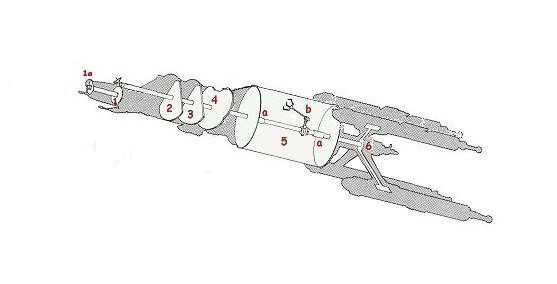
image edited from published material, copyright TSR
Avenger Squadron (assault scout group)
Strike Force NOVA Tactical Assault Scout Unit
(submitted by Shadow Shack)
UPFS Captain Federation
Lead Craft
HS:3 HP:21 Powerplant: 2 Atomic "A"
ADF:5 MR:4 DCR:50
Armament: AR (x4), LB
Defenses: RH, DS
Comm/Detect: SSRadio, Videocom, Intercom, Radar, Energy Sensor
Misc Equipment: streamlined, medium armor, deluxe astrogation
computer: LVL: fp: sp:
Alarm: 2
Analysis: 6
Assault Rocket: 1
Astrogation: 4
Computer Lockout: 6
Damage Control: 2
Drive: 4
Information Storage: 1
Installation Security: 5
Laser Battery: 1
Life Support: 1
Maintenance: 2
Cargo Capacity: 0.5
Crew Accomodations: 4 dbl cabins
Passenger Accomodations: n/a
Ships Vehicles: none
Captain: Stephanie Rogers (fH; S/S:50/65, D/R:75/75, I/L:65/55, P/L:60/70) Pilot(5)
copilot/rocket gunner(2/4), astorgator(4), engineer(5), energy gunner/engineer(5/2)
__________________________________________________
UPFS Hawkeye
#2 Flight Leader
HS:3 HP:18 Powerplant: 2 Atomic "A"
ADF:4 MR:6 DCR:50
Armament: AR (x6)
Defenses: RH, DS
Comm/Detect: SSRadio, Videocom, Intercom, Radar
Misc Equipment: streamlined, light armor
computer: LVL: fp: sp:
Alarm: 2
Analysis: 4
Assault Rocket: 1
Astrogation: 4
Computer Lockout: 6
Damage COntrol: 2
Drive: 4
Information Storage: 1
Installation Security: 5
Life Support: 1
Maintenance: 2
Cargo Capacity: 0.5
Crew Accomodations: 4 dbl cabins
Passenger Accomodations: n/a
Ships Vehicles: none
Captain: Clin Bar-tinn (mY; S/S:65/65, D/R:80/70, I/L:55/55, P/L:50/50) pilot(4)
copilot/rocket gunner(2/6), astrogator/engineer(3/2), engineer(4)
__________________________________________________
UPFS Iron Scout
#3 Flight Leader
HS:3 HP:24 Powerplant: 2 Atomic "A"
ADF:4 MR:4 DCR:50
Armament: PL(LR), PLT (x2)
Defenses: RH, DS
Comm/Detect: SSRadio, Videocom, Intercom, Radar, WNB
Misc Equipment: streamlined, heavy armor
computer: LVL: fp: sp:
Alarm: 2
Analysis: 4
Astrogation: 4
Computer Lockout: 6
Damage Control: 2
Drive: 4
Information Storage: 1
Installation Security: 5
Laser Battery: 1 (x2)
Laser Cannon: 1
Life Support: 1
Maintenance: 2
Cargo Capacity: 0.5
Crew Accomodations: 4 dbl cabins
Passenger Accomodations: n/a
Ships Vehicles: none
Captain: Toni Starc (fH; S/S:90/90, D/R:50/50, I/L:60/50, P/L:60/50) pilot(4) copilot/energy gunner(2/3), astrogator(2), engineer(3), energy gunners(4,4)
__________________________________________________
UPFS Thor
Wingman to UPFS Hawkeye
HS:3 HP:18 Powerplant: 2 Atomic "A"
ADF:5 MR:4 DCR:50
Armament: EG, AR (x2), LB
Defenses: RH, DS
Comm/Detect: SSRadio, Videocom, Intercom, Radar
Misc Equipment: streamlined, light armor
computer: LVL: fp: sp:
Alarm: 2
Analysis: 4
Assault Rocket: 1
Astrogation: 4
Computer Lockout: 6
Damage Control: 2
Drive: 4
Information Storage: 1
Installation Security: 5
Laser Battery: 1
Laser Cannon: 1
Life Support: 1
Maintenance: 2
Cargo Capacity: 0.5
Crew Accomodations: 4 dbl cabins
Passenger Accomodations: n/a
Ships Vehicles: none
Captain: Ronald Blake (mH; S/S:60/75, D/R:65/65, I/L:75/60, P/L:50/60) pilot(3)
copilot/energy gunner/rocket gunner(2/2/2), astrogator(2), engineer(4), energy gunner(5)
__________________________________________________
UPFS Vision
Wingman to UPFS Iron Scout
HS:3 HP:15 Powerplant: 2 Atomic "A"
ADF:6 MR:4 DCR:50
Armament: PL (x2, linked), PLT
Defenses: RH, DS
Comm/Detect: SSRadio, Videocom, Intercom, Radar
Misc Equipment: streamlined
computer: LVL: fp: sp:
Alarm: 2
Analysis: 4
Astrogation: 4
Computer Lockout: 6
Damage Control: 2
Drive: 4
Information Storage: 1
Installation Security: 5
Laser Battery: 1
Laser Cannon: 1
Life Support: 1
Maintenance: 2
Cargo Capacity: 0.5
Crew Accomodations: 4 dbl cabins
Passenger Accomodations: n/a
Ships Vehicles: none
Captain: Symin Liptin (mD; S/S:60/80, D/R:50/50, I/L:60/70, P/L:45/55) pilot(3)
copilot/energy gunner(2/3), astrogator(2), engineer(3), energy gunner/engineer(4/2)
__________________________________________________
UPFS Wasp
Wingman to UPFS Captain Federation
HS:3 HP:18 Powerplant: 2 Atomic "A"
ADF:5 MR:4 DCR:50
Armament: LB (x3)
Defenses: RH, DS
Comm/Detect: SSRadio, Videocom, Intercom, Radar
Misc Equipment: streamlined, light armor
computer: LVL: fp: sp:
Alarm: 2
Analysis: 4
Astrogation: 4
Computer Lockout: 6
Damage COntrol: 2
Drive: 4
Information Storage: 1
Installation Security: 5
Laser Battery: 1 (x3)
Life Support: 1
Maintenance: 2
Cargo Capacity: 0.5
Crew Accomodations: 4 dbl cabins
Passenger Accomodations: n/a
Ships Vehicles: none
Captain: J'nit-Vn'diin (fV; S/S:50/60, D/R:60/60, I/L:65/65, P/L:60/60) pilot(3)
copilot/energy gunner(2/3), astrogator(2), engineer(4), energy gunners(3,3)
__________________________________________________
Basic Ship Computer Package (Knight Hawks)
The following table list the base Computer Program's needed for a starships.
Computer Program
| Description / Source
|
| Astrogation | Knight Hawks Table pg. 40
|
| Drive | Knight Hawks Table pg. 37-38
|
| Life Support | Knight Hawks Table pg. 39
|
| Alarm | Level is equal to number of drives
|
Damage Control
| Level is equal to number of drives |
| Maintenance | Level is equal to number of drives |
| Analysis | Level equal to Astrogation Program
|
| Industry | Level 1: Machine Shop and Hydroponics
|
* Page references are for
Knight Hawks RemasteredThe owner/builder may add in any other desired programs as needed. Some examples include but are not limited to;
- Weapons and Defensive systems
- Commerce Program for trade vessels
- Laboratory for research
- Other specialty software such as security programs, etc.
Suggested ProgramsCommunication Level 1
This program can be utilized to coordinate intercom networks on ships larger than HS:2.
Installation Security Level 1
This program can handle the Skin Sensors without buying the Skin Sensor software package, in addition to any other internal security measures (surveilance cameras, locks on hatches, etc)
Clarion-class Strike Cruiser
Clarion-class Strike Cruiser
In f.y. 69, the Frontier Security Council placed a bid for a cruiser-class starship with more speed and firepower than the current Hargut-class vessels, to serve as flagships for the soon-to-be formed Joint Reaction Forces, PGC and Interstellar Industries submitting the winning Clarion-class design, the first three of which were built just at the outbreak of the Second Sathar War.
The design sacrifices armor and missile battery armament in favor of additional laser and torpedo weaponry and a vastly improved acceleration rating and maneuverability, the Clarion itself proving its combat effectiveness during the Battle of the White Light Nebula, when it singlehandedly destroyed three Sathar heavy cruisers and crippled an assault carrier.
Upon the development of the pion engine system in f.y. 72, the Clarion, along with her sister ships, the Hargut, the Gran Quivera and the Tereldrom, underwent refitting, their four PGC Eureka engines being exchanged for a pair of Interstellar Industries/Mhneme Confederated Shipwrights size C Pulsar pion engines, the refit serving the Clarion particularlly well during the Battle of the Blockade a year later, where, in spite of being badly damaged, the cruiser proved instrumental in the destruction or dispersal of an enemy reinforcement fleet bound for Kdikit.
Specifications
HS: 12 HP:56 Powerplant: 2 II/MCS Pulsar Pion “C” engines
ADF: 5 MR:4 DCR: 100 Crew: 70
Armament: HLC(x2), TT(x10), HLB(x2),PB, EB
Defenses: RH, ABM(x8), ICM(x8), MS
Communication/Detection: Subspace Radio, Videocom, Radar, Energy Sensor, Intercom, WNB
Miscelleanous Equipment: Cargo Arm
Cargo Capacity: 5.0
Crew Accomodations: 12 single cabins, 29 double cabins
Passenger Accomodations: n/a
Ship’s Vehicles: Escape pod(x20), 5 large launches, 4 workpods, (Clarion and Hargut only): Six Boomerang starfighters.
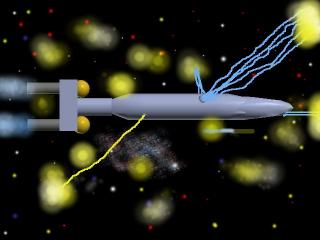
Container Cruiser
SS Knight Crawler
PGCD-35 Container Cruiser
(submitted by Shadow Shack)
HS:35 HP:210 Powerplant: 4 Ion "E"
ADF:1 MR:1 DCR:195 Crew:70
Armament:Rotating LC & DC, LB(x4), EB(x4), PB(x4); 12 fighters
Defenses:RH, MS(x3), ICM (x18)
Comm/Detection:SSRadio, Radar (3x range), VideoCom, Energy Sensor(2x range), WNB Deluxe, Skin Sensors, Camera System
Misc Equipment: Light Armor, Cargo Arms (x3), Deluxe Astrogation, Back-up Life Support, Med Lab, Enviro Lab, Atmoprobe (x4), Landing Drone
COMPUTER
Alarm (6), Analysis (6), Astrogation (4), Bereaucracy (5), Cargo Arm (2) x3 , Commerce (2), Communication (2), Computer Lockout (6), Computer Security (6), Damage Control (6), Disruptor Cannon (2), Drive (6), Electron Beam Battery (2) x4 , Guidance/Analysis (3), Industry (2), Information Storage (6), Installation Security (6), Interceptor Missile (3), Laboratory (3) x2 , Language (6), Laser Battery (1) x8 , Laser Cannon (1), Life Support cap:120 (1) x2 , Maintenance (3), Proton Battery (2) x4 , Robot Management (6), Stasis Screen (3), Transportation (2)
Cargo Capacity:29 (3 main holds @ 7U each w/cargo arms, 4 auxilliary holds @ 2U each)
Crew Accomodations:10 suites, 30 double cabins
Passenger Accomodations: 10 Journey Class & 4 First Class (all double occupancy)
Ship's Vehicles: 12 F-42C fighters (2 bays), 4 shuttles (separate pens), 6 lifeboats, 16 large launches, 8 workpods; external docking facility for a UPF assault scout
Just as the Sovereign Domain Authority began their conquest of the Frontier, Pan Galactic Shipyards completed their largest of the non-military grade dreadnoughts. Pressed for time, the ship's maiden voyage incorporated the evacuation of numerous retreating UPF warships which included a destroyer, two frigates, and four assault scouts.
The basic hull itself stretches out to a dizzying 1420 meters, 1575 meters counting the engines (each of which are about the size of a UPF light cruiser at 300 meters in length). It's 350 meters at the widest point, although the majority of the width resides at 200 meters. The main holds are large enough to house up to a HS:6 vessel, the four auxiliary holds can contain an assault scout in each - not counting the foreward external docking facility that was intended as a courtesy for planetary militia inspections.
The extensive weaponry, while insufficient to defeat any dreadnought class warship, proved capable enough against the smaller capital ships of SDA. A new concept was applied to the Container Cruiser, a prototype design for the forward firing weapons. Seeing as the typical dreadnought lacks the maneuverbility to fully utilize any forward firing weapons, the two cannons were instead mounted on huge gimbals in order to rotate a full 360 degrees on a single plane. This allows the weapons to fire either fore or aft, thus warding off any stern attacks with heavier weapons.
Coupled to the main guns and the twelve batteries are six twin fighter bays, each of which can support a pair of standard fighter craft for a total of two 6-unit squadrons. Four shuttle pens allow the housing of craft intended to move personnel and supplies between the massive craft and stations too small to berth it. Even though a class:6 station can accept the dreadnought, oftentimes there simply isn't enough room with other craft already berthed. A 35 day wait can be a bit much, so typically the ship would orbit the planet near the intended station. Numerous launch pens are scattered along the cruiser's hull, easing the workload of the multiple lift shafts within as crew members opt to take a launch to another deck rather than utilize the arterial elevator network. Finally, eight workpods are berthed in the stern.
Triple range radar units and a double range energy sensor array give the craft sufficient early warning. The ion drives can create a "window" to shield it from inbound craft long before they acquire the massive vessel on their radars. The ship is simply too slow and clumsy to get out of its own way let alone avoid a collission, but also far too massive to be concerned with such collissions with other craft, it could be likened to an insect hitting the windscreen of a skimmer.
Its massive size and vast arsenal also makes it practically immune to the predation of pirates. After all, it would take an extensive fleet of such craft to overtake it, and the entire fleet would have to survive in order to simply make off with the cargo.
F-42C Eliminator
F40C redevelopement
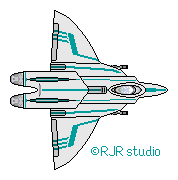
HS:1 HP:8 Powerplant: two sub-Atomic A
ADF:5 MR:5 DCR:30 Crew: 1-2
Armament: Assault Rocket (x2), Pod Laser or PL(x2, linked)
Defenses: RH
Communication/Detection Equipment: Subspace Radio, Radar, Videocom
Misc: Heavy Armor, Auto-Eject Module, Streamlined
Computer
Alarm (2), Analysis (3), Assault Rocket (1), Astrogation (1), Auto Eject (2), Computer Lockout (4), Damage Control (2), Drive (4), Information Storage (1), Laser Cannon (1) x2 , Life Support (1), Maintenance (2), Weapon Link (1)
Based on the wildly successful F-40C standard fighter, the Eliminator takes its cues from the variant twin hull F40C2. Rather than mating a pair of fuselages together via a common wing, the F-42 simply incorporates a second drive in order to boost armament and maintain performance.
Offensively, the craft boasts a standard pod laser system along with a convertible assault rocket launcher that supports two rockets. The launcher/magazine can be swapped out for a second pod laser system, which can be alternatively linked to the fixed system (firing once for 2d10 damage) or discharged individually (two shots at 1d10 each).
Pan Galactic was able to secure twelve of them from WarTech prior to the SDA conquest, and loaded them into the cruiser's bays in time for its fated maiden voyage. To date, the craft have performed remarkably well, although they have yet to be tested with assault rockets as the civilian arms clause does not permit ownership of the launchers. However, considering the vessel's assistance with former UPF loyalists, the day may soon be coming where the launchers will be made available for use...
Corona Phoenix
SS Corona Phoenix
RT-3100 Merchant Scout
(submitted by Shadow Shack)
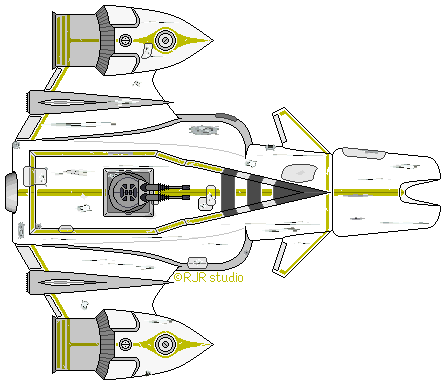
HS: 3 HP: 15 Powerplant: 2 Atomic A
ADF: 4 MR: 4 DCR: 30 Crew: 4-8
Armament: LB (x2)
Defenses: RH
Communication/Detection: SubSpace Radio, VideoCom, Radar, Skin Sensors, Intercom
Misc Equipment: Streamlined, Deluxe Astrogation,Universal AirDock
COMPUTER
ALARM (2)
ANALYSIS (6)
ASTROGATION (4)
BUREAUCRACY (2)
COMMUNICATION (1)
COMPUTER LOCKOUT (4)
COMPUTER SECURITY (6)
DAMAGE CONTROL (2)
DRIVE (Atomic) (4)
INDUSTRY (1)
INFORMATION STORAGE (1)
INSTALLATION SECURITY (4)
LIFE SUPPORT cap:8 (1)
LASER BATTERY (1) x2
MAINTENANCE (2)
ROBOT MANAGEMENT (4)
Cargo Capacity: 2 (1.5 main hold, 0.5 aft hold)
Crew Accomodations: 4 double cabins
Passenger Accomodations: n/a
Ship's Vehicles: none
Ship's Locker contains one armored spacesuit for each player character, along with magnetic boots, 2 emergency patch kits, 2 extra LS packs, and an anchor w/100m cable
The Corona Phoenix is a small freight hauler loosely based on a retired assault scout hull design. The design incorporates fattening across the middle but shortening the overall length, all in all the vessel is sporting a 10% variance over a standard class:3 hull.
In her former incarnation, the craft went by the name of "Knight Owl". The Owl crash landed on Evergleem (Triad's lunar colony) and her crew was never seen or heard from again. The wreck was claimed by Shat Rat's Salvage, where she was later sold to a group of spacers who reconstructed and ressurected the vessel. Due to political reasons, the name change was mandated as the former craft was on a "wanted list" and the new owners did not wish for that kind of attention.
The Corona Phoenix served its owners for nearly 10 years before being sold. Now, the new crew is looking to make a name for themselves smuggling goods across the Frontier, and they have done well in their first year together. Good enough to garner the attention of the writers of said "wanted list"...
original deckplans can be viewed at http://ssknightowl.20m.com
Dreadnoughts
Dreadnought \dred' not\ n. 1. A British battleship, completed in 1906 -- 1907, having an armament consisting of ten 12-inch guns, and of twenty-four 12-pound quick-fire guns for protection against torpedo boats. This was the first battleship of the type characterized by a main armament of big guns all of the same caliber. She has a displacement of 17,900 tons at load draft, and a speed of 21 knots per hour.
Dreadnoughts are known for being large and having big guns...
(submitted by Shadow Shack)________________________________________________________
A sub-project that will deal with ships larger than HS:20. Facets will include the following:
> Who owns them
> Why have them
> What makes them special
> Why are they needed in the UPF/Frontier
> Construction
> Where they can be built
> Cost
> Hull Specifications
> Skills
Part 01: Project Inspiration
Day of the Juggernaut
A Star Frontiers Knight Hawks scenario
by William Tracy
Dragon Magazine, #91, pg. 74
In the weeks following the famed Battle for Volturnus (detailed in the module SF2, Starspawn of Volturnus), the Sathar made no threatening moves against the Frontier. The atmosphere in the UPF was tense for weeks, but gradually calm returned and military forces were taken off their heightened alert status. Just as the races of the UPF were feeling safe again, the Sathar initiated a new attack.
While an assault scout from Scree Fron was on patrol on the outer edge of that star system, the scout came under attack from a gigantic ship that had just exited the Void nearby. The scout was able to send out a distress call before being destroyed, and it reported that the huge ship was heading for the inhabited world of Hakosoar.
Whether by pure good fortune or with the knowledge of the Sathar (who may have seen this as a test of their fighting vessel), a recently reorganized Strike Force NOVA was present at Hakosoar. Instantly, the force admiral ordered his fleet to defend the planet at all costs, and the fight was joined.
Unknown to the UPF, the gigantic ship was an experimental Sathar war machine, a prototype completely automated and commanded by onboard computer systems and robots. Its mission was to reach Hakosoar and orbit the planet three times, bombarding the major cities with space-to-ground missiles. Though of horrifying size, the war machine was the only one of its kind. The Sathar built only one Juggernaut, since the cost was enormous, but they were willing to consider building other robot ships if this one proved itself against the Federation's best.
Sathar Forces
SAV Juggernaut (robot warship)
HP 480 ADF 1 MR 1 DCR 300
Weapons: DC, LB (x8), PB (x2), EB (x4), T (space-to-ground missiles) (x16), RB (x20)
Defenses: RH, ES, PS, SS, ICM (x24)
The Juggernaut carried a new type of robotic short-range fighter, known to the Federation as the Scorpion (hull size 2). The fighters were programmed for launch the moment a UPFS vessel came within 100,000 km (10 hexes) of the Juggernaut.
20 Scorpions
HP 10 ADF 3 MR 3 DCR 29
Weapons: LB
Defenses: RH
UPFS forces (Strike Force NOVA)
UPFS Admiral Clinton (battleship)
HP 120 ADF 2 MR 2 DCR 200
Weapons: DC, LB (x3), PB, EB (x2), S (x4), T (x8), RB (x10)
Defenses: RH, ES, PS, SS, ICM (x12)
UPFS Zamra and Grak (heavy cruisers)
HP 80 ADF 2 MR 1 DCR 120
Weapons: LB (x2), PB, EB, DC, S (x2), T (x4), RB (x8)
Defenses: RH, ES, PS, SS, ICM (x8)
UPFS Courage and Glory (light cruisers)
HP 70 ADF 3 MR 2 DCR 70
Weapons: DC, LB, EB, PB, RB (x6), T (x4)
Defenses: RH, ES, SS, ICM (x8)
UPFS Shimmer, Zz'Nakk, Z'Gata, and Driadia (frigates)
HP 40 ADF 4 MR 3 DCR 70
Weapons: LC, RB (x4), LB, T (x2)
Defenses: RH, MS (x2), ICM (x4)
UPFS Scimitar, Dagger, Rapier, Lancet, and Razor (assault scouts)
HP 15 ADF 5 MR 4 DCR 50
Weapons: AR (x4), LB
Defenses: RH
Scenario set-up
A planet counter should be placed in hex 2819, in the center of the Knight Hawks space map; this is the planet Hakosoar. Note that Hakosoar has five natural satellites, but for the purposes of this scenario they need not be placed on the mapboard.
The Juggernaut, with all fighters aboard it, will enter the game map from either of the "shorter" sides of the rectangular map. Initially, it will have a speed of 5 hexes/turn, and will be decelerating so that it may enter orbit around Hakosoar. Once a spacecraft has reached a speed of 1 hex/turn and moves into a hex adjacent to Hakosoar (without heading directly into the planet), it may take up orbit around that world at a constant speed of 1 hex/turn.
The UPFS player may place his starships anywhere on the game map; the ships may start up to 5 hexes/turn, facing in any direction. The UPFS player automatically knows in which direction the Juggernaut is approaching and may arrange his forces accordingly.
Tactics and victory conditions
The Juggernaut will head immediately for Hakosaor, and will (initially, at least) let its Scorpions take care of the UPFS ships. It will not fire any of its space-to-ground missiles until it reaches the planet, then will fire 1 missile per turn at the planet as its orbits the world, bombarding the major residential and industrial centers. The ship may, of course, fire any of its weapons systems at attacking UPFS ships while bombarding the planet.
Once it finishes firing all of its missiles, the Juggernaut will attempt to flee. If it leaves the mapboard, regardless of how many UPFS ships are chasing it, it is assumed to have escaped and made it into the Void without further damage. If the Juggernaut is destroyed or leaves the map at any time, the Scorpions will self-destruct and will not attempt to be picked up by their parent ship.
If the UPFS ships destroy the Juggernaut before it reaches Hakosoar to begin its bombardment, the Federation wins the battle. If the Juggernaut is able to orbit the planet but fires fewer than six missiles before it is destroyed, the Federation wins a marginal victory. If the UPFS ships cannot stop the Juggernaut from bombing the planet, but destroy the war machine before it can leave the map, the game is a draw. If the Juggernaut can escape from the mapsheet, the Sathar have won.
Part 02: Campaign Background
Frontier News Network
Operation:Dreadnought Bill Passes by Narrow Majority
---Morgaine's World, Prenglar
f.y. 5/33/70
The Council of Worlds finally approved the bill that allows for larger than Class:20 military craft. The bill wasn't being taken too seriously at first, that is until the recent appearance of what the UPF dubbed as the "Juggernaut", a massive Sathar vessel that dwarfed small space stations in sheer mass. This opened the eyes of many UPF strategists and they realized that the possibility of more (or worse yet, larger) craft of such magnitude would spell certain doom for the Frontier.
Immediately following the passage of this bill, military contracters drafted blueprints for such craft as a class:24 craft dubbed "Strike Cruiser", a class:30 hull dubbed as a "Stike Carrier" that can carry up to 24 fighter craft or 6 assault scouts in its massive bay, all the way up to one enormous class:50 craft that will simply be known as a "Frontier Cruiser".
News of passage brought smiles to WarTech executives, following a recently awarded extension of their Battleship contract which now translates to even more of their craft that will be called on as support to such larger craft, hinting that the construction of as many as five more battleships may be contracted within the next year or two. And little doubt exists that their offices in the Gran Quivera shipyard will host some of the initial dreadnought constructions as well. Needless to say, shares of WarTech stock should be enjoying more healthy gains in the near future. Pan Galactic is another happy company, an increase in carriers means an increase in their star fighter production. They are also in the final reviewing stages for a new updated frigate design, no doubt a wide array of smaller capital ships will be required to serve as escort duty for the larger ships on their way.
But Streel executives aren't frowning. Their new shipyard in Cassidine is scheduled to pump out a completely revamped Heavy Cruiser design with modern features that will blow away the original leftovers from the first Sathar War. CEO Hilo Headow (ym) was quoted as saying "We're confident that once all this gets underway, our new cruisers will become the mainstay capital ship of UPF fleets. Add to that, they cost less and we can produce them quicker than our competition's battleships. There's a certain advantage to being number two: it lets the competition know that there's something uncomfortable up their backsides, and when it's all said and done they still have to look behind them to see what it is." Spacefleet is considering the purchase of no fewer than three of the new craft, assuming the prototype lives up to Streel's marketing promises.
Many rallies staged by the Frontier Peace Organization expressing their outrage cropped up during the time this bill was up for consideration, and most of them continue to rage today. Some of them turned violent as supporters from the Anti-Satharian League gathered nearby for retaliating demonstrations. ASL leader J. Harrington Farnsworth (hm) was quoted saying "We're all very happy about the passage of Operation: Dreadnought. It's about time the UPF stepped up their efforts." With regards to the FPO, he simply said "When those fools are done hugging their trees, I hope for their sake a strangler chute drops down on them before a worm blasts them in the back. It's always nicer to die thinking that you were right." FPO leaders were unavailable for comment.
An ammendment for the possibility of larger civilian freight haulers and liners is now up for consideration.
Part 03: Why a Dreadnought?
One word: Carriers.
The standard assault carrier carries 12 fighters at the most. Tactically a fighter can maneuver and accelerate enough to access nearly any target on the battlefield, and if organized as a group effort they can quickly dispatch a capital ship. However they're easily destroyed and require frequent rearming should they survive. So why not have another 12 fighters on stand-by?
Offensively, 12 assault rocket armed fighters can be launched to contend with capital ships while an additional 12 pod laser armed fighters can be dispatched to take care of enemy fighters without sacraficing the heavy weapons of the first unit. Nothing is worse than wasting a rocket on another fighter that could have been used to take out a destroyer.
The dreadnought carrier offers multiple configurations for accomodating such squadrons.
Part 04: Who has Dreadnoughts?
The Sathar first introduced such a craft, a robotic cruiser/carrier combination dubbed by the UPF as "the Juggernaut". If the sathar have more of these monstrosities, and in varying configurations, they stand to hold a better hand against the UPF in an invasion. Imagine a full on carrier of the same size, dropping out of the void along with a contingent of destroyers, and launching multiple squadrons of fighters to take out UPF warships while the destroyers make their way effortlessly to their targets.
It behooves the UPF to have equivilent sized carriers that can ferry variable numbers of standard, light, and heavy fighters to face such an onslaught. Hence the formation of the Operation: Dreadnought bill.
Part 05: Dreadnought Construction
Currently the only two shipyards capable of producing dreadnought sized vessels are the orbital Class:I Spaceship Construction Centers in Triad (Cassidine) and Gran Quivera (Prenglar). Even so, these two centers would be hard pressed to accomodate the construction of something larger than a battleship without some serious expansion work on the centers themselves.
To this end, War Tech has pledged to begin construction of a third Class:I center in Hargut (Gruna Garu). While the Triad and Gran Quivera centers will be capable of expanding and building long before the Hargut center is up and running, the third center was chosen from past Sathar entry point history: to date they have yet to enter the Frontier from the Yazirian worlds. Add to that with WarTech holding a majority of warship contracts, they'll be able to produce them at a lesser cost locally. Which only means the UPF fleets can begin enjoying larger numbers of fighters, assault scouts, frigates, and destroyers in short order.
Part 06: Specifications
Here are a few tables for creating Dreadnoughts in Star Frontiers.
| HS | Leng/Diam | #drives & type | ADF/MR | Hull Cost Modifier |
| 20 | 600/100 | 8 C | 2 / 2 | 1 |
| 21 | 640/106 | 2 D | 2 / 2 | 1.5 |
| 22 | 680/112 | 3 D | 2 / 2 | 1.5 |
| 23 | 730/120 | 4 D | 2 / 2 | 1.5 |
| 24 | 780/128 | 6 D | 2 / 2 | 1.5 |
| 25 | 840/136 | 8 D | 2 / 1 | 1.5 |
| 26 | 880/145 | 2 E | 2 / 1 | 2 |
| 27 | 940/160 | 2 E | 2 / 1 | 2 |
| 28 | 1000/175 | 2 E | 2 / 1 | 2 |
| 29 | 1060/185 | 3 E | 2 / 1 | 2 |
| 30 | 1120/200 | 3 E | 2 / 1 | 2 |
| 31 | 1180/210 | 3 E | 2 / 1 | 2.5 |
| 32 | 1240/220 | 4 E | 2 / 1 | 2.5 |
| 33 | 1300/230 | 4 E | 2 / 1 | 2.5 |
| 34 | 1360/240 | 4 E | 2 / 1 | 2.5 |
| 35 | 1420/250 | 4 E | 2 / 1 | 2.5 |
| 36 | 1480/260 | 4 E | 1 / 1 | 3 |
| 37 | 1540/270 | 6 E | 1 / 1 | 3 |
| 38 | 1600/280 | 6 E | 1 / 1 | 3 |
| 39 | 1675/290 | 6 E | 1 / 1 | 3 |
| 40 | 1750/300 | 8 E | 1 / 1 | 3 |
| 41 | 1825/315 | 2 F | 1 / 1 | 3.5 |
| 42 | 1900/330 | 2 F | 1 / 1 | 3.5 |
| 43 | 2150/345 | 3 F | 1 / 1 | 3.5 |
| 44 | 2300/360 | 3 F | 1 / 1 | 3.5 |
| 45 | 2450/375 | 4 F | 1 / 1 | 3.5 |
| 46 | 2600/400 | 4 F | 1 / ½ | 4 |
| 47 | 2750/425 | 6 F | 1 / ½ | 4 |
| 48 | 2900/450 | 6 F | 1 / ½ | 4 |
| 49 | 3050/475 | 6 F | 1 / ½ | 4 |
| 50 | 3200/500 | 8 F | 1 / ½ | 4 |
MR: ½ relates to making one 60º facing change every other combat turn
| HS | Leng/Diam | #drives & type | ADF/MR | Hull Cost Modifier |
| 51 | 3300/525 | 2G | ½ / ½ | 5 |
| 52 | 3400/550 | 2G | ½ / ½ | 5 |
| 53 | 3500/575 | 3G | ½ / ½ | 5 |
| 54 | 3600/600 | 3G | ½ / ½ | 5 |
| 55 | 3800/625 | 4G | ½ / ½ | 5 |
| 56 | 4000/650 | 4G | ½ / 1/3 | 6 |
| 57 | 4200/675 | 5G | ½ / 1/3 | 6 |
| 58 | 4400/700 | 6G | ½ / 1/3 | 6 |
| 59 | 4600/725 | 7G | ½ / 1/3 | 6 |
| 60 | 4800/800 | 8G | ½ / 1/3 | 6 |
Anything over HS:60 becomes impractical for biological operation as the ADF would be restricted to 1/3, insufficient artificial gravity for long term crew survival
____________________________________________________________________
Dreadnought Drive Tables
Table 1: Atomic Drives
| Hull Size | Engine Size | Cost(SCC:1) | Fuel Pellet Capacity | Trips Between Overhauls | Program Level/FP |
| 21-25 | D | 1,000,000 | 15 | 20 | 6(256) |
| 26-40 | E | 1,500,000 | 25 | 30 | 6(512) |
| 41-50 | F | 3,000,000 | 40 | 50 | 6(1024) |
| Hull Size | Engine Size | Cost (SCC:1) | Fuel Pellet Capacity | Trips Between Overhauls | Program Level/FP |
| 51-60 | G | 4,500,000 | 60 | 75 | 6(2048) |
Table 2: Ion Drives| Hull Size | Engine Size | Cost(SCC:1) | Program Level/FP |
| 21-25 | D | 300,000 | 6(96) |
| 26-40 | E | 600,000 | 6(192) |
| 41-50 | F | 1,000,000 | 6(384) |
No Ion Drives available in the G rating, as the ADF would be ¼ which would be insufficient for long term crew survival
The Alarm, Damage Control, and Maintenance programs will all be at LVL:6 at double the function points. Likewise, any supplemental software will also need to be doubled, such as Commerce, Communication, Industry, and Transportation (for the ship's cargo manifest logs, intercoms, hydroponics/machine shops, and elevators respectively) at LVL:2 instead of LVL:1
Escort Frigate
PGCMF-52 Escort Frigate
(a.k.a. Light Frigate)
(submitted by Shadow Shack)
HS: 5 HP: 30 Powerplant: 3 Pan Galactic "Eureka" Atomic B
ADF: 4 MR: 4 DCR: 60 Crew: 24
Armament: LC, LB(x2), RB(2 salvo)
Defenses: RH, MS(x2), ICM(x4)
Communication/Detection: SubSpace Radio, VideoCom, Radar, Energy Sensor, WNB, Intercom
Misc: Light Armor
Computer
Alarm (3), Analysis (4), Astrogation (4), Bureaucracy (1), Commerce (1), Communication (1), Computer Lockout (5), Computer Security (4), Damage Control (3), Drive (5), Industry (1), Information Storage (1), Installation Security (5), Interceptor Missile (3), Laser Battery (1) x2, Laser Cannon (1), Life Support, cap:32 (1) x2, Maintenance (3), Rocket Battery (2)
Cargo Capacity: 2.5
Crew Accomodations: 1 dbl suite, 7 dbl cabins, 2 quad cabins
Passenger Accomodations: 2 dbl suites, 2 dbl cabins
Ship's Vehicles: small launch, 2 workpods, shuttle
An updated design that was originally seen following the first Sathar War, this ship utilizes most of the original deckplans from those original warbirds produced after said war. However, the layout is about all that remains. Modern military electronics and miniturization allows for a versatile ship that is both effective in smaller engagements as well as transport duties. The Escort Frigate, occassionally referred to as a Light Frigate, has a smaller crew than the full warbird equivilent. Ditching the torpedo system and several other guns, the trade off is performance. Pan Galactic's infamous "Eureka" atomic drives push the envelope for a capital ship, offering both extensive acceleration and maneuverability seen only in smaller craft. Naturally the Light Frigate can not tackle fleet engagement as it is somewhat lacking in terms of front line duty, but it is well armed against pirates and other smaller threats.
Space Fleet and local militias alike use these vessels (the latter being the most common), and several civilian organizations have acquired them as well via government charters. The passenger decks are not lavishly equipped but serve their purpose. The cargo hold is not large enough to be profitable either, but it accents a fleet's capacity in terms of transferring goods without dispatching a warship away from duty for such trivial duty. Escorts in the service of a planetary militia typically join with any Space Fleet vessels insystem as an envoy, as well as serving as a flagship for those militias that don't employ a full-on frigate or destroyer. Space Fleet uses them as advanced scout craft to compliment the firepower of their assault scouts as well as detached duty vessels that range ahead or venture on return trips without sacraficing any warships from the current maneuvers.
DECKPLANS FOLLOW ---
Escort Frigate DECK:01 --- Forward Sensors
1> Hatch to Forward Maneuver Deck
2> Maintenance Panels for lift shafts
3> Radar unit
4> Communications Array
5> Energy Sensor
6> hatch to small launch
Escort Frigate DECK:02 --- Forward Maneuver Banks
click image for full size version
1> Elevators
2> RCS Maneuver Jet banks
3> Back-up Life Support unit
4> cieling hatch to forward sensor deck
Escort Frigate DECK:04 --- Officer Quarters
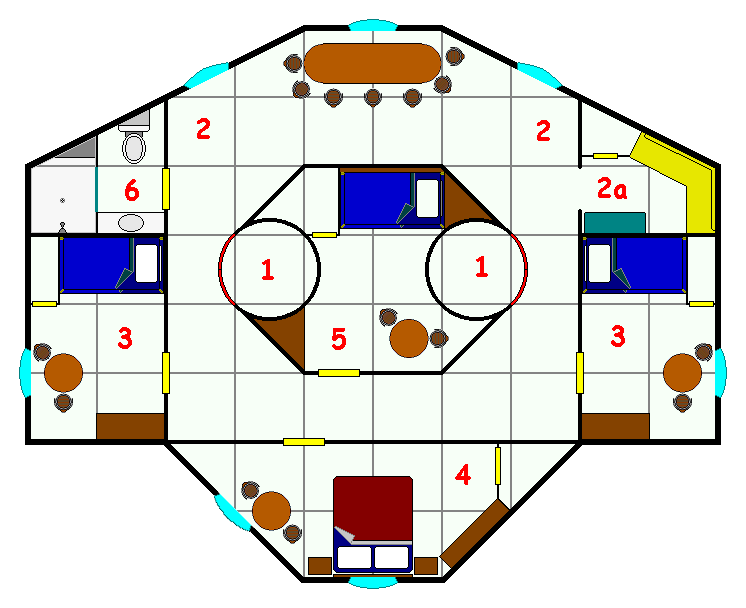 click image for full size pic1> Elevators
click image for full size pic1> Elevators
2> Common Area, 2a is the galley
3> Port & Starboard Cabin, double occupancy
4> Captain's Suite
5> Central Cabin, double occupancy
6> Fresher/Sanitation
Escort Frigate DECK:05 --- Gunnery Deck
1> Elevators
2> Starboard Laser Battery
3> Galey
4> Port Laser Battery
5> Double Bunk Cabin
6> Magazine
7> Rocket Battery, 7a = rocket salvo loading mechanisms
Escort Frigate DECK:06 --- Crew Quarters
1> Elevators
2> Common Area, 2a is the galley
3> Airlock to Shuttle
4> Two double bunk cabin
5> double bunk cabin
6> fresher/sanitation
Escort Frigate DECK:07 --- Passenger Deck
1> Elevators
2> Common Area, 2a is the galley
3> Air Lock/Outer Hull hatch (Universal Air Dock)
4> First Class cabin
5> fresher/sanitation
6> Journey Class cabin
7> Storage
Escort Frigate DECK:08 --- Cargo Hold
1> Elevators
2> Hold
3> Cargo Bay Doors
Escort Frigate DECK:09 --- Aft Maneuver Banks
1> Elevators
2> Maneuver Jet Banks
3> Primary Life Support unit
4> Fresh Water tank, 4a is a water purification plant/sewage disposal unitHydroponics fill the port and starboard areas
Escort Frigate DECK:10 --- Engineering
1> Elevators
2> Engineering Station
3> Parts Storage
4> Airlock/Decontamination Chamber, engine access
5> Workshop - 5a is a workbench, 5b is a foundry. 5c is tool storage, 5d is a laser drill press, 5e is a laser-lathe
6> Generator
7> Power Relay Station
8> Workpod airlock
Escort Frigate DECK:03 --- Bridge
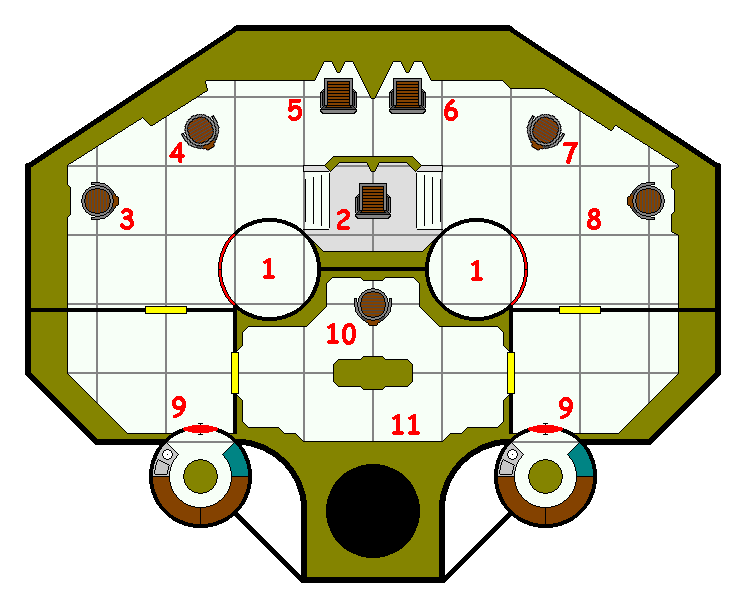 click image for full size version
click image for full size version
1> Elevators
2> Captain's position
3> Computer Officer station
4> Astrogator station
5> Helm - pilot station
6> Helm - copilot/energy gunner station
7> Chief Engineer station
8> communication/detection officer station
9> escape pods
10> Mainframe Computer
11> Laser Cannon maintenance/access
FAS Oath-Bound
Free Alliance Ship Oath-Bound
The oldest ship still on active-duty, the FAS Oath-Bound began life as the first of Star Law's Oath-Bound-class frigates, participating in every major event in the old Federation's history, including the Battle of Ten Fleets, the Krataar Incident(where she played a pivotal role), the Battle of Snowball(where, again, she played another pivotal role)and the Second Sathar War, serving with Task Forces Liberty and White Light.
In f.y. 72, the Oath-Bound was completely gutted and rebuilt as the test-bed for the both the new pion drive system and the artificial gravity systems, before being dispatched to participate in the Battle Of Moonworld. Reassigned to Task Force White Light, she was present when the Juggernaut Fleets devastated Star Law during the Second Battle of Madderly's Star, the ship acquitting herself during the course of that bloody battle, destroying a Juggernaut and a pair of heavy cruisers, before retreating to Clarion, where she was to participate in the Second Battle of White Light, singlehandedly destroying the Leviathan-class dreadnaught Gargantua, the destroyers Hosanna and Righteous, and a dozen corvettes, escort carriers and cruisers.
After this battle, Oath-Bound was redesignated a strike cruiser, undergoing further modifications to carry a squadron of fighters and a single SR-15 scoutcraft, as well as laboratory facilities, the ship serving alternately in the Fleet and the Exploration Service over the course of the next twenty-three years, distinguishing herself well in nearly every major engagement the Free Alliance has fought in, including the Battle of Twenty-Seven Fleets, and, most recently, the Fourth Battle of Truane's Star, and the Third Battle of Volturnus.
Although the ship is nine decades old, she has been throughly modernized, and remains in active service, both as a symbol of the old Federation and its ideas, and as a decorated and effective combat vessel in her own right.
She is currently attached to Battle Group McCoy, serving as an independent unit.
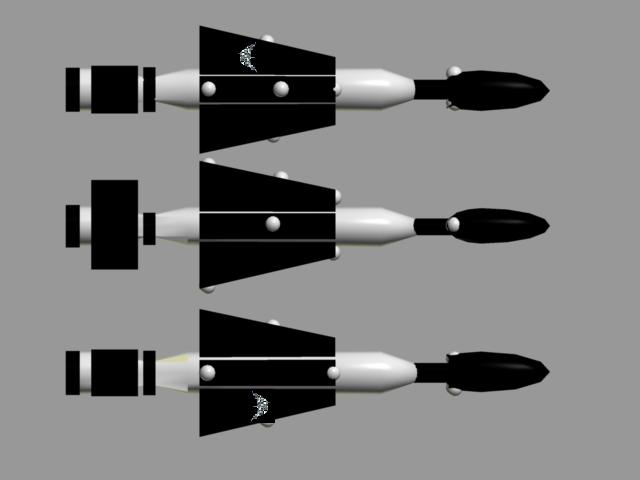
Specifications:
HS: | 5 | SP: | 600 | DCR: | 50 |
ADF: | 6 | MR: | 6 | MP: | 7 |
Total Volume: | 17,662.5 m3 | Mass: | 1,261.61 tons | Cost: | TCr21.2 |
Crew: | 34 | Powerplant: | 1 Interstellar Industries PulsarB Void Engine |
Comms: | Subspace Radio, Holoprojectors |
Detection: | Subspace Radar, Energy Sensors, ECM, Probes(×8), Decoys(×8) |
Intranet: | Mastercomp(Level 6), Piloting(Level 6),Astrocomp(Level 6), Gunnery(Level 6; ×11), Engine(Level 6) |
Armament: | HLC(×10),MLB(×10), MDC(×2), TT(×50) |
Defenses: | MS, ICM(×40), ABM(×40) |
Vehicles: | Escape Pod(×5), Lifeboat, Launch(4 person), Launch(10 person), Fighter(×6), Scoutcraft |
Other Systems: | Laboratory, Cargo Arm |
Cargo Space: | 1381 m3 |
Interceptors (anti-fighter craft)
Interceptor

Size 1 or 2 (small fighter-type craft)
Two type-A atomic engine
Anti-fighter spacecraft
Launched from anything that holds a fighter (the larger interceptors take up twice the space)
7 hull points (larger have 10)
Size 1: one pod laser battery (mounted underneath, 2d10, directional, range 9) and two assault rocket launchers (one on each wing)
Size 2: Two pod laser batteries (one on each side of the cockpit, 2d10, directional, range 9) and three assault rocket launchers (one underneath, one on each wing)
Able to land and take off of planets
MR of 6, ADF of 5
Crew: small, 1,
large, 2
Faster than a fighter, these quick light craft have less HP than a normal fighter, but carry over three times the payload. Not meant for attack on capital ships due to their small size, these ships almost defy the laws of physics with their weaponry, as most ships their size wouldn’t be able to handle the power of multiple assault rockets or pod laser batteries. Their upgraded military technology allows them to carry weapons formerly thought impossible for this type of craft, but the ultralight raritanium upgrade and smaller size of the pod laser batteries allows these craft to use them to great effect against their counterparts. The assault rockets are automatically fed into the launchers, allowing the pilot(s) to focus most of their flying power on dodging maneuvers. Each launcher carries 4 rockets, and because the rockets are made out of a superlight metal called terrabranium it allows them to move faster, dealing an extra 2 damage to anything it hits. The launchers themselves come at an extra cost, as it now takes an extra 1,000 to buy a rocket and an extra 5,000 for the launcher. The upgrade for the pod laser batteries costs an extra 2,500. These small craft pack quite a punch, and enemy fighters should have a tough time fighting these masters of destruction.
Jump Tug
Jump tug stats can be found here.
(by Terl Obar)
Ever wonder how all those star systems
that don't have a Starship Construction Center get their system
ships? If they can't make them and the ships are not Jump capable,
how did they get there? The answer: The Jump Tug. This vessel
consists of little more than a small crew module, some massive
engines and a long boom used to attach the ships it transports.
Unloaded, it is one of the fastest ship on the Frontier (especially
the smaller model). With crews of three to six beings, these ships
traverse the space lanes moving other ships throughout the Frontier.
Characteristics
Jump tugs are based on a size 5 hull.
Any smaller and the hull can't support the stresses. While they
could be larger, you are decreasing towing capacity and increasing
cost for no real benefit. Despite their relatively large size on
paper, the hulls of these ships are in truth physically small as most
of the hull material has been used in reinforcing the engine struts
to handle the massive engines mounted on these small hulls and to
create the boom, which is 350m long. Although their small hull size
would normally use Class B engines, Jump Tugs sport 4 Class C Atomic
engines. The relatively small hull size combined with the large
engines give the Jump Tug some unique characteristics that make it
ideally suited for the role of interstellar ship transport.
Sporting the Class C Atomic Engines,
the Jump Tug only needs an overhaul once every twelve jumps through
the Void. This means that a Jump Tug is able to make at least one
round trip from any SSC to any system in the Frontier without an
overhaul.
Because of the over-sized engines on
the small hulls, these ships are able to move a large number of other
ships all at once. The Jump Tug can ferry ships up to a total
combined hull size of between 25. To put that into perspective, it
would only take 4 Jump Tugs to move any one of the UPF Task Forces
(Cassidine, Prenglar or Nova) between systems. (5 to take Prenglar if
you took the Minelayers)
The large engines also mean that,
unloaded, these ship are fast. Unloaded, they have ADF and MR values
of 61. In fact, it's not uncommon for Jump Tug captains
to hold impromptu “drag races” on off days for bragging rights on
who has the fastest ship around.
Of course having these large engines
mounted on these small hulls comes at a price. The hulls have to be
incredibly reinforced to withstand the large stresses placed on the
ship. This extra reinforcement uses up most of the available hull
material leaving little to be used for actual crew space. As a
result the crew area is smaller than an entire hull size 2 vessel!
On the plus side, because of the reinforced hull, these ships are
sturdier than their traditional counterparts and have more hull
points.
Crew
Because of the limited space available
for the crew, Jump Tug crews are small, typically three to four
beings and never more than six. At a minimum the crew needs a pilot,
an astrogator and an engineer. Many times the crew will include a
second astrogator to speed up jump calculations. Crews, especially
on independently owned tugs, may have a few extra engineers in the
crew to speed up the overhauls when they are needed. (It can be a
drag to overhaul four Class C Atomics all by yourself.) While crews
are typically in the three to six range, there are tugs out there
that are run by a single, albeit highly skilled, being. Whether
because they like the solitude, just need more personal space or some
other reasons, these spacers choose a solitary life among the stars.
Hauling Capacity
Jump Tugs can haul up to 5 times their
own hull size in towed ships Their actual performance (ADF/MR)
depends on the total hull sizes of all the ships being towed on a
specific jump. Table 1 summarizes some basic performance information
about the Jump Tug giving the total Hull Size that can be towed for a
given ADF/MR.
|
Tug Hull Size
|
5
|
|
Number of Engines
|
4
|
|
Maximum Total HS of Ships Hauled
|
25
|
|
Unloaded Max ADF/MR
|
6
|
|
Max total HS towable with ADF/MR of 1
|
25
|
|
Max total HS towable with ADF/MR of 2
|
10
|
|
Max total HS towable with ADF/MR of 3
|
5
|
|
Max total HS towable with ADF/MR of 4
|
2
|
|
Max total HS towable with ADF/MR of 5
|
1
|
|
Max total HS towable with ADF/MR of 6
|
0
|
Ships are towed by attaching them to
the long boom extending from the bow of the tug. Generally, the
ships are arranged around the boom to balance out the center of mass
and keep it in line with the center of mass of the tug. However, if
hauling a ship of HS 13 or larger (or any single large vessel and a
bunch of smaller ones), the large vessel is attached at the tip of
the boom via the large force diffusing plate at the end of the boom.
This allows the mass to be balanced properly for the trip.
Economics
While it is possible to make a bigger
tug (based on a hull size 6 or 7 hull) with more (6 or 8) engines
that could haul slightly more ships per jump, they are not cost
effective. The hull size 5 ship described here cheaper to both
purchase and operate and any potentially larger version. One Class C
Atomic engine costs more than all of the rest of the ship systems
combined. Thus, adding more engines, the most important part of the
hauling power, dramatically increases the cost. On the other hand,
it doesn't drastically increase the towing capacity. Doubling the
engine count, nearly doubles the cost of the ship but only gives a
32% increase in towing capacity. In addition, the larger ship would
require more fuel per jump and more maintenance down time for
overhauls.
Typical charges for a tow is 5000 cr
per point of hull size per jump. However, depending on circumstances
it could be as low as 2000 cr per point of hull size or as high as
16000 cr per point of hull size per jump. depending on the
destination, age of ship, number of ships being towed, etc. Details
are left to the discretion of the Referee (see “Operating a Jump
Tug” below).
Operating a Jump Tug
Based on the Knight Hawks stats given
below, the cost of a Jump Tug is 3,621,100 cr unfueled. It takes
another 400,000 cr to completely fuel the tug enabling 10 jumps.
Assuming the tug makes 40 jumps a year, has a crew of three (Pilot 4,
Astrogator 3, Engineer 3) and spends an average of 10.5 days in
annual maintenance. The total operating cost of the tug (maintenance
cost, fuel and salaries) is 1,890,500 cr per year. Amortized over 40
jumps that reduces to 47,263 credits per jump. With a full load of
25 hull size worth of ships per jump this comes to 1891 cr per hull
size per jump. This gives us the bare minimum a tug captain can
charge and still break even, namely 2000 cr per hull size per jump.
However, this makes several
assumptions. The biggest is that the ship is completely paid for!
Assuming the captain financed 3.5 million cr (nearly all) of the cost
of the ship for 10 years. That adds another 1,428,350 cr per year to
the operating costs. Again amortized over the 40 jumps per year adds
35,709 cr per jump or 1429 cr per hull size.
Another assumption is that the tug
makes all jumps completely full, i.e. hauling a full 25 hull sizes
worth of ships. This is rarely the case, there are usually a few
slots unfilled. In addition, if the tug is delivering ships to a
remote system, there may be nothing to haul back to the SSC where the
tug makes its base. In this case, there is nothing to defray the
costs of the jump so they have to be absorbed into the cost of other
jumps. Of course if they are not hauling anything they can simply
operate 2 of the four engines to save some cash.
In the end all, of these things go into
figuring the cost of operating the the Jump Tug. The 5,000 cr per
hull size per jump is just an average number assuming the ship is
mostly paid for, the tug is relatively full and can usually bring
back a few ships on a return trip.
Deck Plans
The Jump Tug has four decks. They are,
from top to bottom: the bridge, the crew deck, the airlock and
engineering. Figure 1 shows the deck plans for the Jump Tug.
Descriptions of the labeled areas of the ship are given below.
Elevator – The decks are
connected by a single elevator (1.5m diameter) designed to carry a
single being at a time. However, two can squeeze in if they want to
get cozy. This elevator runs to all four decks of the ship
Pilot's Station – This computer
station is the pilot's seat on the ship and has all of the controls
for flying the ship.
Astrogator's Station – This is
the astrogator's work station for plotting out the ship's jumps.
Main Computer – This is the main
computer system for the ship housing all the ships functions and
programs.
Crew rooms – Each room can be
used by up to two beings. The rooms each contain a desk and chair
as well as a bunk bed. The bed is mounted in such a way that one or
both of the beds can be stowed up into the ceiling of the room to
make additional floor space if desired. If only one being is using
the room, the second bed can be permanently stowed with the first
one being either at ground level or raised. In addition, if one of
the inhabitants is a Vrusk, the second bed can be stowed with the
first one raised and specialized Vrusk resting couch/bed can be
placed on the ground level.
Restroom – This room contains a
small sink, toilet facilities and a shower.
Common room – The common room
contains a small table, four additional chairs and the galley. There
is also an entertainment center (area 8).
Entertainment Center and Life
Support Machinery – This part of the ship is filled with an
entertainment center to keep the crew occupied during the long
voyages as well as part of the ship's life support equipment.
Ship Machinery – various parts
of the ships life support system, computer, and other machinery fill
up the majority of this deck.
Spacesuit storage locker – This
room is primarily designed to hold the crews' spacesuits but can be
used for miscellaneous storage as well.
Airlock – This is the ship's
airlock. It can hold up to 3 spacesuited beings at one time.
Entryway – Small entry room that
beings entering or leaving the ship can use to remove or don their
spacesuits.
Engineer's station – This is the
engineering station on the ship and has the computer the engineer
uses to monitor and control the ship. Can be used as an auxiliary
bridge.
Storage – General storage locker
for the ship.
Ship Machinery – More space
taken up by general ship machinery.
Workpod – The ship's workpod.
Used for hull repairs and to assist in mounting ships to be towed.
Access is through a pressure door that links with the airlock of the
workpod.
Engine access tunnels – These
tunnels allow access the the engines from with the ship.
Figure 2 shows the full ship to scale
with its engines and the boom for attaching the ships to be towed.
The boom is a solid piece of hull metal, 350m long and 2 m in
diameter. The force diffusion plate on the end is a 1m thick plate
30m in diameter. Figure 3 is a close up of the body of the ship
showing the relative placement of the decks inside the hull.
Full KH Stats
Here are the full KH statistics for the
Jump Tug.
Jump Tug
HS: 5
HP: 40
Engines: 4 Class C Atomic
Max ADF/MR: 6/6 (when fully
loaded, the Jump Tug has an ADF/MR of 1)
DCR: 35
Max Towing Capacity: 25 Hull
Size worth of ships
Life Support: up to 6 beings,
primary and backup
Crew Accommodations: 3 double
occupancy cabins
Computer Level/Function points:
Level 4/198 FP
Computer Programs: Drive 6,
Life Support 1, Alarm 4, Computer Lockout 4, Damage Control 4,
Astrogation 4, Commerce 1, Communications 1, Computer Security 2,
Information Storage 1
Astrogation Equipment: Standard
Starship
Communications Equipment: Radio
w/4 screens, Subspace Radio, Intercom w/ 2 master panels and 10
speaker/mikes
Sensor Systems: Standard Radar,
10 Portholes, double camera system (for watching all the towed ships)
Weapons: None
Defenses: Reflective Hull
Ship's Vehicles: Workpod
Total Cost(unfueled): 3,621,100
cr. (400,000 cr to fully fuel the engines)
1 Assuming the Referee
allows performance like this in the campaign. If not the upper limit
can be whatever the Referee decides applies.
Author's Note:
The baseline for the calculations in
this article is the fact that a HS 15 ship requires 4 Class C Atomic
engines and has an ADF/MR of 2. All of the math that went into
ADF/MR and towing calculations were done using the hull size of the
ships being towed, not their volume/mass as would be more realistic.
This was done in keeping with the simplicity that is Star Frontiers.
Anyone who has ever really looked at the Knight Hawks “Hull
Specification Chart” (p11 of the KH Campaign Book) has probably
realized that the size of the ships do not increase linearly with
hull size, rather they increase exponentially, i.e a HS 10 ship is
not 10 times bigger than a HS 1 ship. Rather it is almost 10,000
times bigger. And a HS 20 ship is 150,000 times bigger than a HS 1
ship, not just 20 times larger. Thus in reality, if my tug could tow
one battleship (HS 20), it should be able to tow 150,000 fighters (HS
1) or 4800 Assault Scouts (HS 3) if you just looked at volume/mass.
Obviously that doesn't fit within the Knight Hawks cannon framework.
Plus the math required on the part of the GM/players gets really
involved and the point is to keep it simple. If it helps, you can
think of the limitations imposed by using the hull size as coming
from the attachment points on the towing boom. You can only cluster
so many ships around the towing boom before all the attachment points
are filled. To do this properly, where the ADF/MR reduction and
number of ships towed was based on volume/mass instead of hull size,
would actually require a rewriting of the star ship construction
rules to bring hull size, ship volume and engine characteristics onto
a consistent and realistic framework.

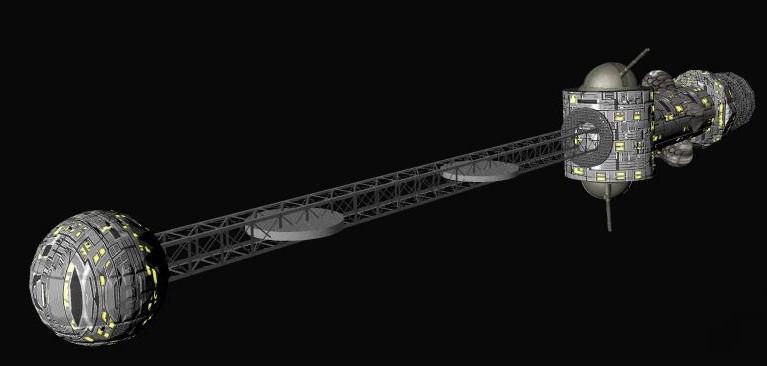
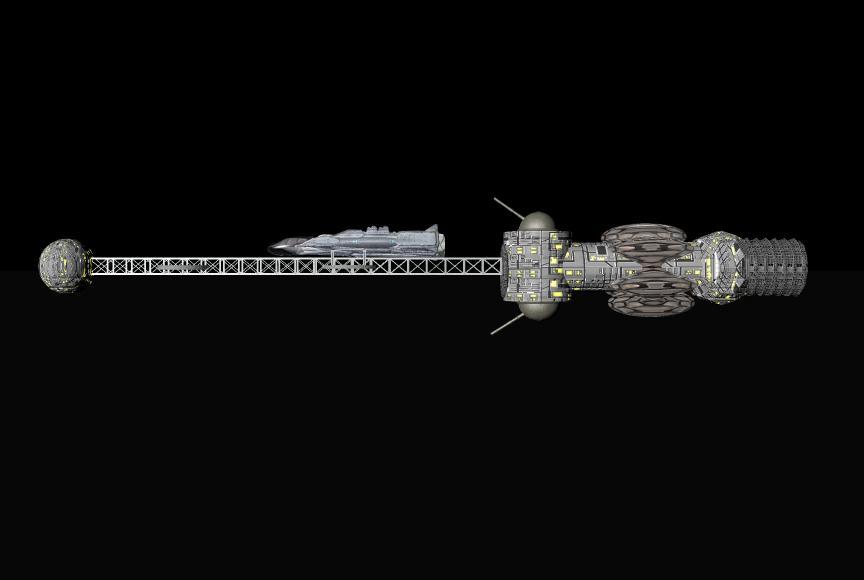
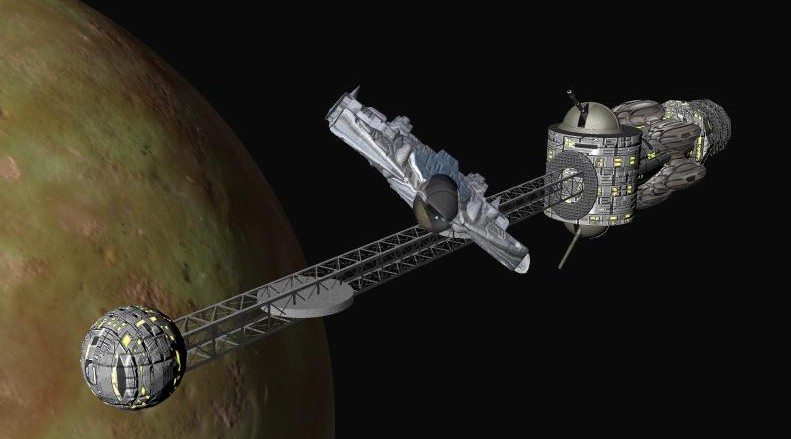

Kri'kkaa-class shuttle
Kri'kkaa-class Heavy Shuttle
HS: 2 HP: 10 Drives: 1 Chemical A
ADF: 1 MR: 1 DCR: 26 Crew: 1 (up to 10 passengers)
Armament: None
Defenses: None
Communication/Detection: Videocom radio (1 screen), holo-display and holo keyboard, shuttle astrogation.
Misc: 5 portholes (2 bridge, 2 passenger, 1 airlock); 1 airlock, rear cargo doors.
Computer: LVL: ?, FP: ?, SP:100; software: Standard shuttle package I
Cargo Capacity: 2 units (approx. 27 cu. m)
Crew Accommodations: Gel contour seat
Passenger Accomodations: 10 stow-able seats
Ship's Vehicles: Standard Explorer or other (10 cu. m space) or use for extra cargo.
Base Price: 185,409 (includes 1 load fuel (500 Cr. Does not include spacesuits or toolkits).
A very common shuttle of Vrusk design, this oblong ovoid shows its insectoid heritage by sporting two ovoid cockpit portholes, a finely-polished iridescent green hull, and 6 landing struts that unfold from the hull. Upon entering an atmosphere, stowed memory-metal wings and rudder unfold from the hull, while an atmosphere-breathing scramjet assists the chemical drives with landing.
Numerous Kri'kkaa shuttles are found in used lots, and mercs and freelancers find they make a fine compliment to their starships ... after some repainting of course. Oddly, the shuttle seems well suited to both albedo and plasma screens - but this requires and additional powerplant that consumes a good portion of the cargo space. Often a turret-mounted laser piston is found on customized models, which can look even more insectoid when painted in camoflage colors.
Thanks to a large clamshell cargo hatch at the read, the shuttle is often used to carry heavy vehicles for ground exploration or combat.
Design created using Knight Hawks and "Frontiers of Design" (Dragon Magazine April 1988) from which I fitted out the suggested available space.
Melinda McCoy II
SS Melinda McCoy II
CC 2543 (formerly the UPFS Melinda McCoy)
Salvaged/Demilitarized UPF Destroyer
(submitted by Shadow Shack)
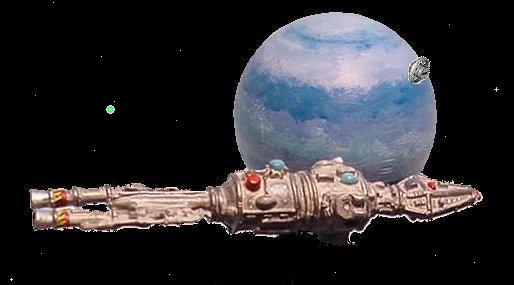
HS: 6 HP: 50 Powerplant: 2 Streel "Big Bang" Atomic B
ADF: 3 MR: 3 DCR: 60 Crew: currently 8
Armament: Heavy Laser Cannon, Electron Beam Battery, Laser Battery, Rocket Battery
Defenses: RH, ICM (x5)
Communication/Detection Equipment: Subspace radio, radar, energy sensor; intercom network, skin sensors
Misc Equipment: Heavy Armor, Cargo Arm, deluxe astrogation equipment
Computer
LVL: 5 fp: 218 SP: 300
Alarm (2)
Analysis (6)
Astrogation (4)
Commerce (1)
Computer Lockout (4)
Computer Security (4)
Damage Control (2)
Drive, Atomic (5)
Electron Beam Battery (2)
Industry (1)
Information Storage (1)
Installation Security (4)
Interceptor Missile (3)
Laboratory, Medical (3)
Laser Cannon (1)
Life Support {capacity:24} (1)
Maintenance (2)
Cargo Capacity: 4.5 (4u main hold w/cargo arm + 0.5u forward hold)
Crew Accomodations: 9 double occupancy cabins
Passenger Accomodation: 4 double occupancy cabins (2 1st Class/2 Journey Class); 4 frozen storage class berths (brig)
Ship's Vehicles: 2 workpods, large launch, combat cutter "Wings of Dawn"
MES Sentinel (I-76 Enforcer)
MES (MalCo Enterprise Ship) Sentinel
I-76 Enforcer heavy fighter
(submitted by Shadow Shack)

HS:2 HP:16 Powerplant: shielded inboard/outboard Atomic A drive
ADF:3 MR:4 DCR:45
Armamament: PL, AR(x2), PLT (pod laser turret)
Defenses: RH, DS(6hp)
Communication/Detection: Subspace Radio, Radar, Videocom
Misc Equipment: Streamlined, Heavy Armor, Auto-Eject Module
Computer
Alarm (1)
Analysis (4)
Assault Rocket (1)
Astrogation (4)
Auto Eject (2)
Computer Lockout (4)
Damage Control (1)
Deflector Screen (2)
Drive (4)
Information Storage (1)
Laser Battery (1)
Laser Cannon (1)
Life Support (1)
Maintenance (1)
Robot Management (3)
Cargo Capacity: 0 (3 cubic meters for personal gear, storage bay for one maintenance robot)
Crew Accomodations: dual seat cockpit w/reclining command chairs, autocooker, and waste disposal unit
Passenger Accomodations: n/a
Ship's Vehicles: maintenance robot WarTech's sibling micro-corporation "Sovereign Virtue" (no relation to the Sovereign Domain Authority)belted out this fantastic heavy duty multi-purpose fighter many decades ago. It's an older design that has been upgraded over the years following WarTech's funding of the company, and has slowly become known as the "workhorse of the Frontier" by former Star Fighter Corps pilots. The Enforcer's shielded atomic drive does not have a governor installed, so it is interstellar capable. The vessel's lacking performance is made up by an ability to take a more severe beating by fighter standards, the rocket payload along with two different beam weapon systems (a forward firing pod laser and an Ion Gun Turret) makes it a versatile craft well suited for many roles.
The Sentinel crew swapped the ion guns for a pod laser turret in order to inflict more permanent damage when the need arises. She flies escort for the SS Corona Phoenix. She carries a LVL:3 maintenance robot in the aft bay to assist with upkeep and repairs.
The forward position is the helm for the pilot, the aft seat is for the astrogator/gunner. Both can recline to form a makeshift bed, aft of the astro/gunner position is an autocooker, sanitizer, and a disposal unit. The aft hatch leads to the storage & maintenance bay, where the vacc suits and maintenance robot are stored. A majority of the ship systems can be accessed here, although accessing some systems requires a spacewalk.
Orion Class Explorer
Document Controller: w00t
Captain Raggs Orion class ship can be found
here.
HS: 2
HP: 40
Powerplant: 4 Ion B
ADF: 1 MR: 1
DCR: 30
Crew: 6
Armament:
Defenses:
Communication/Detection: SubSpace Radio, VideoCom, Radar, Intercom
Computer
Alarm ()
Analysis ()
Astrogation ()
Communication ()
Computer Lockout ()
Damage Control ()
Drive ()
Industry ()
Installation Security ()
Life Support, cap:8 ()
Maintenance ()
Rocket Battery ()
Cargo Capacity:
Crew Accomodations:
Passenger Accomodations:
Ship's Vehicles:
Pacific class freighter
Trans Travel TT6150 "Pacific" Class Freighter
(submitted by Shadow Shack)
 image courtesy of Art @ SF.org forums --- edited by Shadow Shack
image courtesy of Art @ SF.org forums --- edited by Shadow Shack
"Pacific" class name courtesy of SATurn-X @ Omega Rising forums
HS:6 HP:30 PowerPlant: 3 Atomic B
ADF:3 MR:3 DCR:38 Crew:up to 8
Armament: none (LB available at no penalty)
Defenses: none (RH available)
Communications/Detection: SubSpace Radio, Radar, Intercom (3 master panels, speaker/mike in each station/cabin/chamber)
Misc Equipment: Cargo Arm, Universal AirDock
Computer
(LVL:4 fp:127 SP:100)
Alarm (3), Analysis (4), Astrogation (4), Commerce (1), Communication (1), Damage COntrol (3), Drive - Atomic B (5), Industry (1), Life Support cap:16 (1), Maintenance (3)
Cargo Capacity:6
Crew Accomodations: Captain's Suite (double occupancy possible), Crew Cabin w/2 triple bunks
Passenger Accomodations: 1 First Class Cabin, 2 Journey Class Cabins (all double occupancy)
Ship's Vehicles: lifeboat, 2 workpods
Base Price: 2,246,400Cr --- does not include fuel, spacesuits, weapons/defenses, or toolkits
Trans Travel's TT6150 is a popular choice for independant haulers, designed in the early f.y. 40s the ship has been around for a while. As such it has been tried, tested, and found to be true. Used samples can be had for 15 to 50% of new price, depending on condition & upkeep. One such famous sample dubbed the SS Gullwind made what has been historically referred to as "the Dramune Run", thus exposing a criminal organization that kicked off the third Dramune War. One of the craft believed to be responsible for taking the Serena Dawn in Zebulon is theorized to be a pirate owned Pacific class freighter.
Despite the rich history, these fine craft are the envy of many freight haulers. Small, fast, and agile, they make up for smaller payloads by proving rapid delivery. With the advent of Pan Galactic's "Eureka" drive, added acceleration has made it moreso for such equipped Pacifics (adding 100,000Cr per drive and an ADF:4). The optional laser battery, while not the most offensively minded possibility, ensures that such loads can be protected to say the very least.
Paladin Traveller
SS Paladin Travellersalvaged UPF Frigate
(submitted by Shadow Shack)
HS: 5 HP: 40 Powerplant: 3 Atomic B
ADF: 4 MR: 3 DCR: 50 Crew:up to 20
Armament: LC, LB, RB(x4)
Defenses: RH, MS(x1), ICM(x4)
Communication/Detection: SubSpace Radio, Radar, Energy Sensor, WNB, Intercom
Misc Equipment: Heavy Armor, Skin Sensors, Camera System, Cargo Arm
Computer
Alarm: 3
Analysis: 4
Astrogation: 4
Bureaucracy: 4
Commerce: 1
Communication: 1
Computer Lockout: 6
Computer Security: 5
Damage Control: 3
Drive (Atomic B): 5
Industry: 1
Information Storage: 1
Installation Security: 6
Interceptor Missile: 3
Language: 3
Laser Battery: 1
Laser Cannon: 1
Life Support cap 30 : 1 (x2)
Maintenance: 3
Robot Management: 6
Rocket Battery: 2
Cargo Capacity: 2.5
Crew Accomodations: 10 single/double occupancy cabins
Passenger Accomodations: n/a
Ship's Vehicles: lifeboat, shuttle, 2 workpods
Random Ship Generator
{List:Class}
HC-I
HC-II
HC-III
HC-IV
HC-V
HC-VI
{List:End}
{List:hp}
Laser Cannon
Deflector Shields
Torpedo Tube(×10 Torps)
Massdriver
Disruptor Cannon
Proton Cannon
Electron Cannon
Missile Launcher(×20 Missiles)
Point Defense System
Radar
Energy Sensors
WNB
Videocom Radio
Subspace Radio
{List:End} {List:START}
Hull Point: {Roll:6d10=hullpoints} ADF {Roll:1d5=ADF} Your ship has the following equipment: {hp#hullpoints} {BR}Class {Class}. {List:End}
Sathar & Zuraqqor Fighters
(submitted by Shadow Shack)
SIG-21
Sathar light fighter
HS:1 HP:5 Powerplant: single sub-Atomic A
ADF:6 MR:5 DCR:30 Crew: 1
Known Armament: Pod Laser
Known Defenses: RH
Known Communication/Detection Equipment: Subspace Radio, Radar
Theorized Computer
Alarm (1), Analysis (2), Astrogation (2), Damage Control (1), Drive (3), Information Storage (1), Laser Cannon (1), Maintenance (1)
The Sathar SIG-21 is a new light fighter from the devious worms, intended for an anti-fighter role. They're faster than the standard SIG-25 but can't take as much damage, as a result they are easier to destroy assuming you can keep up with them.
______________________________________________________________________________________
SIG-25
standard Sathar star fighter
HS:1 HP:8 Powerplant: single sub-Atomic A
ADF:5 MR:5 DCR:30 Crew: 1
Known Armament: Assault Rocket (x3) or long range Pod Laser
Known Defenses: RH
Known Communication/Detection Equipment: Subspace Radio, Radar
Theorized Computer
Alarm (1), Analysis (2), Assault Rocket (1) or Laser Cannon (1), Astrogation (2), Damage Control (1), Drive (3), Information Storage (1), Maintenance (1)
The SIG-25, an acronym dating back to the first Sathar War that stands for "Sathar Intruding Gunship", is the mainline fighter craft of the sinister intruding foes of the Frontier. Since the formation of new fighter craft wings in the Frontier, the Sathar have been stepping up their fighter tactics so it is unknown whether the basic design is still in use or not. The worms have recently acquired the Pod Laser technology recently as we have discovered several groups armed as such, and speculation has it they may be integrating convertible systems on their fighter craft as we did with our F-40C Vulcan program.
Like all Sathar craft, an intact specimen has yet to be recovered. Any and all attempts to capture have all resulted in the SIG pilot's self destruction of the craft. Suffice to say Auto Eject technology is not part of their fighter program.
______________________________________________________________________________________
SIG-15H
Sathar heavy fighter
HS:2 HP:10 Powerplant: single sub-Atomic A
ADF:5 MR:4 DCR:40 Crew: 2
Known Armament: PL, PLT
Known Defenses: RH
Known Communication/Detection Equipment: Subspace Radio, Radar
Theorized Computer
Alarm (1), Analysis (2), Astrogation (2), Damage Control (1), Drive (3), Information Storage (1), Laser Battery (1), Laser Cannon (1), Maintenance (1)
These menaces have just been discovered. Just as fast as a standard size 1 fighter and nearly as agile, their pod laser turrets compliment the role as an anti-fighter platform. Not very effective on larger warships though, but watch yourselves if you tangle with these fighters.
______________________________________________________________________________________
SIG-29 "Scorpion"
Sathar heavy fighter
HS:2 HP: 15 Powerplant: 2 sub-atomic
ADF: 5 MR: 4 DCR: 40 Crew: 1-2
Known Armament: PL(LR), AR(x2)
Known Defenses: RH
Known Communication/Detection Equipment: Subspace Radio, Radar
Numerous civilian and military vessels have come across these craft, some have been manned and others were not, suggesting possible remote control capabilities. As such, it is difficult to tell what kind of computer software these birds possess.______________________________________________________________________________________
Z-35 Zuraqqor Hive Fighter
HS:1 HP: 8 Powerplant: single Ion A
ADF: 5 MR: 4 DCR: 40 Crew: 1
Armament: PL, IC
Defenses: RH
Communication/Detection Equipment: Subspace Radio, Radar
The standard Zuraqqor fighter craft adds a twist to alien encounters in the form of an Ion Cannon system along with a standard Pod Laser. UPF strategists theorize that the Sathar may intend to have their insectoid allies capture an Assault Scout with craft armed as such.
______________________________________________________________________________________
Z-75 Zuraqqor Raider
HS:2 HP: 15 Powerplant: 2 Ion A
ADF: 4 MR: 4 DCR: 40 Crew: 2
Armament: PL(LR), AR(x2)
Defenses: RH
Communication/Detection Equipment: Subspace Radio, Radar
The insectoid allies of the Sathar have unleashed these ion-driven monstrosities. Despite having less powerful drives than conventional fighter craft, they are still quite swift and agile. Not to mention a fair payload at their disposal to boot.
Ship Cost Charts
placeholder for ships costs and associated dynamics.
| Ship Name | Class
| MR
| ADF
| Weapons
| Defenses
| Cost (CR)
|
Big Daddy
| Haught
| 2
| 1
| none
| none
| 1,000,000
|
| | | | | | | |
Space Vehicles
A list of space vehicles.
Lander
Lander (VC3 space vehicle)
Crew: 10
Cargo: 10 cu storage
BP: 200
DR: 5
Sensory Array
– SRS 0.25 AU (passive)
- LRS 0.25 LY (active)
+0% handling
2g acceleration
10 tons fuel (400 hr at 1g)
Power System
- twin type-6 parabattery
Mass: 100 tons (stows in 15cu)
Cost: 110,000 (56/day rental)
Includes d10 Malfunction/Hit Table
Starship Construction 101
STARSHIP CONSTRUCTION 101
I've always found the MHS rules to be, well, stupid, and the ones offered in the pair of Dragon magazine articles to be lacking.
Over the years, I've developed a starship construction system loosely based on the construction rules in the Traveller supplement High Guard, where each hull starts out with a total volume, with each component added to that frame subtracting from that total.
HULLS
Starship hulls are rated in size according to the table below:
Hull Size | Length | Radius | Total Volume (cubic meters) | Total Mass (tons) |
1 | 10 | 1 | 31.40 | 2.24 |
2 | 30 | 2.5 | 588.75 | 42.05 |
3 | 50 | 4 | 2,512.00 | 179.43 |
4 | 75 | 6 | 8,478.00 | 605.57 |
5 | 100 | 7.5 | 17,662.50 | 1,261.61 |
6 | 130 | 10 | 40,820.00 | 2,915.71 |
7 | 150 | 12.5 | 73,593.75 | 5,256.70 |
8 | 180 | 15 | 127,170.00 | 9,083.57 |
9 | 210 | 17.5 | 201,941.25 | 14,424.38 |
10 | 240 | 20 | 301,440.00 | 21,531.43 |
11 | 270 | 22.5 | 429,198.75 | 30,657.05 |
12 | 300 | 25 | 588,750.00 | 42,053.57 |
13 | 340 | 27.5 | 807,372.50 | 57,669.46 |
14 | 380 | 30 | 1,073,880.00 | 76,705.71 |
15 | 420 | 35 | 1,615,530.00 | 115,395.00 |
16 | 450 | 37.5 | 1,987,031.25 | 141,930.80 |
17 | 475 | 40 | 2,386,400.00 | 170,457.14 |
18 | 500 | 44.5 | 3,108,992.50 | 222,070.89 |
19 | 540 | 45 | 3,433,590.00 | 245,256.43 |
20 | 600 | 50 | 4,710,000.00 | 336,428.57 |
The number of structure points a starship has is equal to (Hull Size ×100).
Changing Structure Points: Starships can add to or subtract up to 50% from their total Structural Points. Additions or subtractions either add to or take up a percentage of the ship's total volume equal to the percentage added to or removed from the ship's total SP.
EXAMPLE: A fighter with 100 SP elects to subtract 50% of its total structural Points from its frame. The fighter will only have 50 SP, but now has 47.1 cubic meters of total volume to use for additional systems and weaponry,
Hulls cost (HS×50,000) credits to construct at a Spaceship Construction Center. All SCCs are Class I, located in orbit around any world with an H population code.
VOID ENGINES
Starships use Void engines to travel both interplanetary and interstellar distances.
A Void engine consists of two parts:
Antimatter Pion Drive
The antimatter pion drive annhilates matter and antimatter to generate power and thrust.
Hydrogen is continously accelerated iinside the acceleration chamber at relativistic speeds, the acclerator benifiting from superconducting materials to generate anti-hydrogen from hydrogen more cheaply, quickly and efficently than was previously possible.
The hydrogen and anti-hydrogen are then annhilated upon anti-hydrogen creation inside the annhilation chamber, with a combination of thermopiles and gamma-particle collectors- fiber-optic filaments of lead crystal doped with lathanide filaments which convert the gamma particle's energy into usuable electricity-with the resulting pions being directed by the engine's magnetic, containment coils through the exhaust chamber, where they are then expelled to provide thrust.
The Void Field Generator
By the time a ship accelerates to a velocity of 3,000 km/s(1% c or 12,000,000 km/hour), its Void engine has generated enough power to engage its Void field generator.
The generator energizes lathanide thermopiles embedded into the skin of the ship to create a field which warps spacetime around a ship, creating a pocket continuum where the ship's relativistic mass is reduced to and maintained at zero, allowing for travel at light speed and beyond.
When the generator goes online, the ship disappears in a pulse of heat and radiation-harmless in space, but making for a pretty light show-the alternate spacetime created by the Void field being called the Void.
The largest Void engines manufactured generate 12,000,000 SEU of power per second(or terajoules), with 99% of the power generated going to thrust and the creation of the Void field, the remaining one percent going to power the ship's energy weapons and other systems.
Time Dialation And Void Travel
A ship in the Void expiriences time-dialation, roughly fifteen seconds passing in warpdrive for each day in normal space.
All ships in the Void travel at the same rate-one light-year per day, translating to a rate of over 300 times the speed of light.
Hazards Of Void Travel
The Void field still interacts with normal space, meaning that solid objects of sufficient density impacting with the outside or the inside of the Void field interface(including another Void field) can disrupt the Void field and completely destroy the ship.
This allows for the mining of known interstellar routes, the mines in question having proximity fuses which detonate upon detection of the heat and radiation pulse resulting from ships in the Void changing the density of local space-time as their Void fields interact with normal space.
It also means that a starship cannot use its weapons, subspace transceiver or subspace lidar while in the Void, since solid objects or other Void fields striking the inside of the Void field interface will destroy the ship.
VOID ENGINE SIZES AND COSTS
Size | Hull Sizes | Volume | Cost |
A | 1 to 5 | 1% of ship's total volume per point of ADF x number of engines | 100,000 Creditsx(1% of ship's total volume per point of ADF x number of engines) |
B | 6 to 20 | 2% of ship's total volume per point of ADF x number of engines | 100,000 Creditsx(1% of ship's total volume per point of ADF x number of engines) |
Starships require (HS/5) engines(minimum 1) in order to maintain a stable Void field geometry.
MANEUVER JET
Starships use maneuver jets for atmospheric flight and maneuvering in both atmosphere and normal space. The maneuver jet system is a single plasma jet engine connected to thrust vectrals located throughout the spaceframe.
The maneuver jet system requires 0.5% of the ship's total volume per point of MR, and costs 25,000×(0.5% of ship's total volume per point of MR).
CREW SPACES AND LIFE SUPPORT
Crew Quarters: 5 cubic meters per crew member, which includes corridors, common areas and control spaces as well as actual quarters.
Life Support: Base of 2 cu. meters plus 0.5 cubic meters per crew member, which includes provisions and artifical grav generators, as well as breathable air and climate controls.
Crew Spaces Cost: 300 credits per crewmember.
REQUIRED CREW
Minimum: Equal to Hull Size
Recommended: Equal to (Hull Size+1/battery weapon+1/missile system+marines+1 medic/ 3 crewmembers.
PASSENGER ACCOMODATIONS
Type | Volume | Cost |
First Class Passenger | 72 m3 | 2,000 per cabin |
Journey Class Passenger | 32 m3 | 1,000 per cabin |
Storage Class Berth | 4 m3 | 2,000 per berth |
Passenger Luggage | 1/3 cabin volume |
Passenger accomodations include life support and artificial grav for the passenger spaces.
COMPUTERS
Computer costs assume 200 function points' worth of programs per computer.
One computer is required for each major ship's system(piloting, astrogation, engines, one for each weapons system, etc.), plus a master computer(or mastercomp) to coordinate the efforts of all the ship's other computers.
All ship's computers are linked together in an optically-wired intranet.
Typical Computer Programs
Mastercomp: Alarm, Lockout, Installation Security, Datalink, Robot Management, most non-specialized computer programs.
Piloting Computer: Piloting, Evasion, Beam Cannon, Targeting
Astrocomp: Astrogation(Interstellar), Astrogation(Interplanetary), Astrophysics, Astronomy, Astrocartography, maps of the Frontier and each of its systems.
Engine Computer: Void Engine, Damage Control, Robot Management
Gunnery Computer(per battery/missile weapon): Battery Weapon, Missile Guidance, Targeting, Vehicles(Remote)
Defensive Computer: Defensive Systems, ECM, Decoy Guidance
Each computer takes up 0.1 cubic meters and costs 200,000 credits.
COMMUNICATION AND DETECTION EQUIPMENT
Subspace Radio: The subspace radio uses Void engine technology to grant a laser beam imaginary relativistic mass, allowing it to exceed the speed of light by a factor of one billion, allowing for instaneous transmission of data and messages between planets, ships in normal space and between star systems no more than 100 light years apart.
The subspace radio comes in a regular size for most starships and a smaller, shorter-range(1 light year maximum range) unit for small craft(Hull Size 1 ships only).
A subspace radio unit takes up 3 cubic meters of space(0.01 cubic meters for the small-craft unit). Both units cost 20,000 credits.
Holoprojectors: Holographic projectors for use with workstations(see below). A single holoprojector takes up 0.5 cubic meters of space and costs 100 credits.
Workstation: A computer workstation is a terminal allowing access to the ship's intranet. It also serves as an intercom unit, using built-in speakers to relay voice transmissions.
A workstation takes up 0.05 cubic meters of space, and costs 100 credits.
Subspace Radar: A subspace radar unit is a lidar system boosted to FTL speeds using Void engine technology. Detection of any object is instaneous out to a range of 10 light years(20 AU for the small-craft unit, see below).
Like the subspace radio, a subspace radar unit comes in two sizes, one for most starships, and a smaller one for small craft
A subspace radar unit takes up 5 cubic meters of space(0.05 for the small-craft unit). Both units cost 10,000 credits.
Energy Sensors: A series of passive sensors designed to pick up emissions in the electromagnetic spectrum, from long-wave radio to cosmic rays. Regular energy sensors can pick up EM radiation(including heat and radiation pulse accompanying the interface of a Void field with normal spacetime) out to a range of 300,000 kilometers, while small-craft energy sensors are restricted to a maximum range of 15,000 kilometers.
Standard energy sensors take up 20 cu. meters of space, while small craft energy sensors take up 0.05 cu. meters of space. Both units cost 200,000 credits.
Camera System: A series of small image-intensifying cameras able to see in nearly every part of the electromagnetic spectrum.
A set of 350 cameras, built into the ship's spaceframe, is sufficent to cover the needs of most starships, and takes up 7 cubic meters of space, while a pair of such cameras suffice to provide a fighter with a 360-degree view of the space around it, taking up a total of 0.01 cubic meters of space. Camera systems, regardless of size, cost 15,000 credits, most of which is installation and calibration cost, rather than the cost of the actual cameras themselves.
Skin Sensors: Embedded into a starship's spaceframe, skin sensors act as proximity warning devices, alerting the crew to craft at point-blank ranges, as well as to hull breaches and probable intrusion attempts.
A standard set of skin sensors includes (HS×200) sensors and takes up (HS×10) cubic meters of space, while a fightercraft is equipped with a single skin sensor, taking up 0.05 cubic meters of space. A set or a single sensors costs the same: 1,000 credits times the ship's hull size, most of this figure being, again, installation and calibration costs rather than the actual component cost.
ECM: A standard suite of electronic countermeasures include a radar window generator and a white-noise broadcaster, amongst other systems designed to suppress electromagnetic emissions and confound enemy sensors.
An ECM suite takes up 50 cubic meters of space and costs 80,000 credits.
Decoys: A series of small missiles with smaller-scale ECM suites designed to fool enemy sensors into believing they are the ship which launched them.
Each decoy takes up 4 cubic meters of space and costs 10,000 credits.
EMERGENCY EQUIPMENT
Escape Pod: Referred to by spacers as "creet buckets," escape pods are single-person escape craft, with enough life support for a tenday, an emergency subspace radio. and a small plasma jet system with enough fuel to thrust at ADF 1 for ten hours.
An escape pod takes up 16 cubic meters of space and costs 30,000 credits.
Lifeboat: A lifeboat holds up to ten people, with enough life support for 40 days, an emergency subspace radio, and plasma jets with enough fuel to thrust at ADF 1 for sixty hours.
A lifeboat takes up 80 cubic meters and costs 100,000 credits.
WEAPONS
Weapon descriptions can be found in the section under combat, above.
Their cost and space requirements are listed below:
Laser Weapons
Weapon | Volume | Cost | |
HLC | 400 | 150,000 | |
MLC | 80 | 15,000 | |
LLB | 1.68 | 8,000 | |
LLC | 0.28 | 8,000 | |
MLB | 120 | 30,000 | |
Charged-Particle Weapons |
Weapon | Volume | Cost | |
PC/EC | 5 | 13,000 | |
HPC/HEC | 300 | 30,000 | |
PB/EB | 10 | 15,000 | |
Massdrivers | | | |
Weapon | Volume | Cost | |
MDB | 20 | 20,000 | |
HMDB | 50 | 35,000 | |
MDC | 75 | 50,000 | |
Missile Systems |
Weapon | Volume | Cost | |
SM | 10 | 10,000 | |
MB | 40 | 60,000 | |
TT | 20 | 20,000 | |
MM | 1 | 5,000 | |
LP | 5 | 9,000 | |
DF | 31.4 | 100,000 | |
MMD | 588.75 | 250,000 | |
Miscellaneous Items | | | |
Weapon | Volume | Cost | |
Grapples | 60 | 25,000 | |
Mines | 20 | 25,000 | |
Defensive Systems |
System | Volume | Cost | |
ABM Launcher | 10 | 20,000 | |
ABM Salvo | 5 | 2,000 | |
ICM Launcher | 10 | 20,000 | |
ICM Salvo | 5 | 2,000 | |
Mag Shielding | 100×HS | 3,000×HS | |
Missiles: Ordinance bays in the bellies of starships house missiles, torpedos and drones(hereafter referred to as missiles); upon launch, the bay doors open, and the desired number of missiles are dropped from the bay into space, where their own engines engage to propel them forward.
The volume and cost of the bay(s) is 50% of the total volume of the missiles being stored there.
EXAMPLE: A ship is being built to hold 20 torpedos. Twenty torpedos cost 400,000 credits and take up 400 cubic meters, and the bay to hold them takes up an additional (400×0.5) 200 cubic meters, costing an additional (400,000×0.5)200,000 credits.
Thus, the bay and the torpedos together take up 600 cubic meters of space and costs 600,000 credits.
SHIP'S VEHICLES
Hangar Space: Ship's vehicles are housed in a hangar bay. The additional cost and space for the hangar bay is equal to 50% of the total cost and volume of the vehicles being stored there.
(In other words, one multiplies the total volume of ship's vehicles by 1.5 to arrive at the total space required for vehicles and the hangar bay, the same going for cost).
Typical Ship's Vehicles
Fighters: Single-person combat starships designed for interception, fleet escort and light anti-ship duties.
Bombers: Small attack starships designed for anti-ship and ground attack duties.
Dropships: Specialized troop transport shuttles holding a company-strength unit, designed both for planetary insertion and boarding.
Shuttles: Generic small utility craft used for passenger and cargo transport.
Launches: Small ship's boats designed for the movement of personnel between ships or between ships and planets.
Launches come in two sizes, a four-person size which generally serves as a captain's gig, and a ten-person size, which serves both as a generic ship's boat and a troop transport for smaller craft.
Sizes and costs are listed below; all reflect the size and cost of the vehicle and the size and cost of the required hangar bay space:
LIST OF SHIP'S VEHICLES
Vehicle | Volume | Cost |
Four-person launch | 30 | 75,000 |
Ten-person launch | 75 | 100,000 |
Fighter | 47.1 | 250,000 |
Bomber | 883.125 | 50,000 |
Drop Ship | 883.125 | 100,000 |
Shuttle | 883.125 | 100,000 |
MISCELLANOUS EQUIPMENT
This listing includes both generic starship gear and specalized equipment for various types of craft as mining vessels, research craft and ag ships.
Digger Shuttle: A shuttle equipped for mining asteroids and uninhabitable worlds. It is equipped with a close-range(300 kilometers max.)drilling laser which can bore through solid rock.
If used as a weapon, a digger's drilling laser can do 4,000 points(400D10) of max structural damage, but is restricted to point-blank range(180 meters or less).
A digger has an ADF and MR of 1.
Held in external racks on a mining vessel, a digger shuttle takes up 150 cubic meters of space and costs 108,000 credits.
Ore Processing Lab: A shipboard facility designed to refined mined ores(and atmospheric gasses). Mining ships often have more than one OPL, so as to refine as much raw material on site as possible in a twenty-hour period.
An OPL requires 1,000 cubic meters of space and costs 100,000 credits.
Seeds: A packet of seeds for use by agricultural ships and stations. Each seed packet takes up (HS×10) cubic meters of space and costs 500 credits.
Nutrient Solution: A vat of nutrient solution provides enough nutrient to grow a packet of seeds hydroponically. Each vat of nutrient solution takes up (HS×40) cubic meters and costs 1,000 credits.
Farming Robot: A farming robot provides automated assistance in planting and harvesting crops on an ag ship or station. A farming robot takes up (HS×2) cubic meters of space and costs 3,000 credits per robot.
Solar Collectors: While solar collectors-clusters of fiber-optic filaments-can provide auxiliary power for starships, they are mainly used to gather the sunlight necessary for ag ships/stations to raise their crops.
Each solar collector take up (HS×10) cubic meters of space and costs 4,000 credits.
Probes: A probe is an small robotic missile used by military and research vessels to gather information; it is capable of both atmospheric and space flight, with an ADF and MR of 60.
A probe takes up 25 cubic meters of space and costs 100,000 credits.
Laboratory: Lab facilities analyze information gathered on site by probes and survey teams.
A laboratory requires 60 cubic meters of space and costs 100,000 credits.
Cargo Arm: A robotic arm used for loading and handling cargo; any starship with cargo capacity requires at least one cargo arm.
Each cargo arm takes up 20 cubic meters of space and costs 25,000 credits.
CARGO BAY
Any space left over can be used for the ship's cargo bay.
Deck Plans
DECK PLANS
The development of artificial grav generators during the Second Sathar War has changed the way ships are laid out. As opposed to the perpindicular to long axis arrangements of older ships, modern ship's decks are laid out parallel to the ship's long axis and generally employ a three-deck design, as follows:
Crew Deck: The topmost deck of most starships, containing crew quarters and other amenities for crew use.
Middeck: The working area of the ship, holding the hangar bay, bridge, galley, sickbay and much of the ship's engineering spaces.
Gunnery Deck: The bottomost deck of a ship, this area holds the controls(and ordinance bays) to most of the ship's weapons and defensive systems.
Cargo Bay: Generally, the cargo bay is situated directly behind the three main decks and accessible by cargo doors either in the dorsal or ventral sections of the spaceframe, as well as by hatches on any of the three main decks.
Void Engine Placement
On most starships, the Void engine(s) is integrated into the spaceframe, as opposed to being placed on struts. The engine(s) is sealed off from the rest of the ship, bathed in supercoolant(to aid in power generation, containment and overall efficency) and are tended to almost exclusively by robots. Void engine(s) are remotely controlled and monitored from the engineering spaces on the middeck.
Bridge
Military starships tend to place their bridges at the center of their middeck areas, for greater security and safety. As opposed to being glassed in(having windows), starship bridges are equipped with holoprojectors showing the view of space as rendered by the ship's sensors, cameras and subspace radar systems.
Scale: 1 square= 2.5 meters.
Omega Mods
These next couple of documents describe modifications made to my system for my Omega campaign setting.
Merely cosmetic, for those who just want to gloss over them.
Omega Mods for KH2K
Omega Mods for Knight Hawks 2000
SYSTEMS
Subspace radios are called warpdrive transceivers.
Subspace radars are called warpdrive lidar systems or, simply lidar.
WEAPONS
Listed below are the common starship weapons of the 22d century.
160 TJ Laser Cannon(HLC): These weapons are the ship-mounted versions of planetary laser cannon. They have a range of 1,800,000 kilometers(30,000,000 hexes), fire once per turn and inflict 4,000 points maximum structural damage(400D10 structural points damage).
40 TJ Laser Cannon(MLC): These smaller cannon are the most common weapons for scoutcraft, with a range of 1,800,000 kilometers(30,000,000 hexes), firing once per turn, and inflicting 800 points(80D10)of maximum structural damage.
5TJ Laser Cannon(LLC): These cannon are common warpfighter and vehicle-mounted weapons. They have a range of 1,800,000 kilometers(30,000,000 hexes), firing twice per turn, inflicting 400 points(40D10)of maximum structural damage per pulse which hits.
Each pulse is a separate to-hit roll.
500GJ Autolaser(AL): Called heavy lasers by AD/Zeb's, these are common secondary warpfighter and vehicle-mounted weapons. In space, they have a range of 1,800,000 kilometers(30,000,000 hexes), firing fifteen times per turn, inflicting 200 points(20D10)of maximum structural damage per pulse which hits.
Each pulse is a separate to-hit roll.
Medium Laser Battery(MLB): This is a turreted medium laser cannon; the turreted mounting allows it to fire into any arc.
Light Laser Battery(LLB): This is a turreted quad mount of light laser cannon; the turreted mounting allows it to fire into any arc.
Heavy Electron/Proton Cannon(HEC/HPC): A heavy weapon which fires either a beam of protons or a beam of electrons at a target. It has a range of 1,800,000 kilometers(30,000,000 hexes), firing once per turn and inflicting 3,000 points(30D10) of maximum structural damage.
Electron/Proton Cannon(EC/PC): A lighter proton weapon which is mounted aboard fightercraft. It has a range of 1,800,000 kilometers(30,000,000 hexes), firing once per turn, inflicting 200 points(20D10) of maximum structural damage.
Electron/Proton Battery(EB/PB): A turreted proton/electron cannon, able to fire once per turn into any arc.
Massdriver Cannon(MDC): A projectile weapon using a powerful magnetic field to propel solid metallic slugs into space at relativistic velocities(about 20 % of the speed of light). It has a range of 360,000 kilometers(6,000,000 hexes), firing twice per turn and inflicting 600 points(60D10)of maximum structural damage.
Heavy Massdriver Battery(HMDB): A turreted pair of medium-sized massdriver cannon, the heavy massdriver battery can fire into any arc, has a range of 360,000 kilometers(6,000,000 hexes), firing four times per turn and inflicting 400 points(40D10) of maximum structural damage.
Massdriver Battery(MDB): A turreted set of four small massdriver cannon, the massdriver battery can fire into any arc, has a range of 360,000 kilometers(6,000,000 hexes), firing eight times per turn and inflicting 200 points(20D10) of maximum structural damage.
Seeker Missiles(SM): Small guided missiles with a Level 3 robot brain, passive and active sensors, a plasma engine, and a one-kiloton antimatter warhead. These are dropped from hardpoints or internal bays, the onboard robot brain using its Missile Guidance(Level 3) program to seek out enemy targets and its Level 3 Vehicular Combat(Starship) program to evade interceptors(q.v.) .
A seeker missile has an ADF and MR of 30, and its plasma engine has enough fuel for ten turns' of acceleration, after which it automatically detonates.
Alternatively, a seeker can be dropped off and programmed to keep station, waiting until an enemy crosses its path, at which point it accelerates towards it.
A seeker missile does 460 points(46D10)of maximum structural damage, and a ship can launch a number of seekers equal to the amount of missiles on board per turn.
Missile Battery(MB): A missile battery is a four-tubed launcher firing smaller seeking micromissiles(see below) which otherwise act as seeker missiles. It fires at a rate of four salvos per turn, each missile having enough fuel to accelerate at ADF 30 for six turns before detonating.
Each salvo does 400 points(40D10) of maximum structural damage.
Torpedos(TT): A torpedo is twice as large as a regular seeker missile, with a Level 6 robot brain guiding its actions(with Missile Guidance and Vehicular Combat(Starship) programs at Level 6) and a one-megaton antimatter warhead doing 1000 points(100D10) of maximum structural damage. Its plasma engine has enough fuel to accelerate at ADF 30 for twenty turns before automatically detonating.
It otherwise acts like a seeker missile.
Micromissiles(MM): These are the missiles from the missile battery, carried externally and used by fighters and bombers for air-to-air(or space-to-space)combat.
In all respects micromissiles act like missile battery salvos; cost and volume are for four micromissiles.
Laser Pod(LP): The laser pod is a pair of five-terajoule laser cannon in a gunpod, designed to give warpfighters much-needed punch. It has the range and damage of a regular light laser cannon.
Drone Fighters(DF): These are remotely-piloted fightercraft with a Level 6 robot brain and a full array of Astrogation, Gunnery and Starship Pilot programs, all at Level 6 as well.
Armed with the standard array of fightercraft weapons, drone fighters inflict 400 points(40D10) of maximum structural damage per turn, making up to four attacks per turn.
Multi-Missile Drones(MMD): Seen on destroyer and dreadnaught-class starships, multi-missile drones are robotically-piloted bombers(with the same robot brain and programming as the drone fighter, above) armed with either 230 torpedos or 460 seeker missiles on board.
Assuming it releases its entire payload in one turn, a multi-missile drone can inflict 6900 points(690D10)of maximum structural damage per turn.
Grav Beam: Grav beam projectors project a short-range(120 meter)grav beam which otherwise acts as a set of grapples, using the canon Knight Hawks rules for grappling, save for the fact that a ship caught in a grav beam can make a successful Starship Pilot roll to escape the grav beam or use the same chance for grappling to sever the grav beam with the ship's own.
Ships caught in a grav beam can be pulled towards the grappling ship at a rate of one hex per turn.
Grav beams can also be used defensively to augment the ship's grav shielding, subtracting 25% from any incoming attack's chance to hit.
A grav beam used defensively cannot be used for grappling in the same turn and vice-versa.
Mines(M): Mines are antimatter warheads which can be emplaced in a volume of space by a ship equipped for minelaying. Mines are proximity-fused, with passive sensors which detect magnetic flux, heat and radiation(such as the heat and radiation pulse made when the density of local spacetime is changed by a drivefield intersecting it)and detonate.
Each mine does 1000 points(100D10)maximum structural damage per turn, and a ship can lay a number of mines per turn equal to its maximum load, for a maximum of 10 mines per hex.
SHIP's VEHICLES
If a ship is carrying space vehicles, it can launch them as an attack as well.
Starting Speed:Vehicles(and missiles) launched from a ship begin the game with the same speed as the platform which launched them.
Remote Piloting: Missiles and drones launched from a ship can be remotely piloted from the ship. The remote pilot uses his Vehicles: Remote or Gunner: Missiles skill and half of the missile/drone's robot brain's Vehicular Combat(Starship) skill to guide the missile/drone to its target.
DEFENSIVE SYSTEMS
Auto-Laser Quad Battery(ALQB): Four autolasers mounted in a robotically-controlled turret, designed for point-defense against missiles and fighters. Each ALQB fired in a turn subtracts 25% from any incoming missile's chance to hit.
Anti-Beam Missiles(ABM): Similar in structure to an ICM, an anti-beam missile has a warhead of water(which turns to ice vapor in space) and strips of gold foil which blanket an entire hex upon detonating, thus providing a defense against both laser and particle-beam weapons.
ABMs are launched in salvos of four, blanketing four hexes in a line up to sixty hexes(3,600 meters) away from the ship launching them, each salvo subtracting 25% from the chance to hit for each beam weapon which passes through the cloud it creates, the beam's damage being reduced by 25% even if it passes through the cloud successfully.
An ABM has an ADF and MR of 60, with an endurance of one turn, after which it detonates.
Grav Shielding(GS): Grav shielding generates a skin-tight field of artificial gravity around starships HS 2 or larger, deflecting beams and missiles away from the ship.
Grav shielding subtracts 50% from a missile or beam weapon's chance to hit, halving the damage of any beam or missile which hits.
Warp Engines
Starships use warp engines to travel both interplanetary and interstellar distances.
A warp engine consists of two parts:
Antimatter Pion Drive
The antimatter pion drive annhilates matter and antimatter to generate power and thrust. Hydrogen is continously accelerated iinside the acceleration chamber at relativistic speeds, the acclerator benifiting from superconducting materials to generate anti-hydrogen from hydrogen more cheaply, quickly and efficently than was previously possible.
The hydrogen and anti-hydrogen are then annhilated upon anti-hydrogen creation inside the annhilation chamber, with a combination of thermopiles and gamma-particle collectors— fiber-optic filaments of lead crystal doped with lathanide filaments which convert the gamma particle's energy into usuable electricity—with the resulting pions being directed by the engine's gravitic containment coils through the exhaust chamber, where they are then expelled to provide thrust.
The Drivefield Generator
The generator is a powerful grav generator—driven by the antimatter reaction—which energizes lathanide thermopiles embedded into the skin of the ship to create a field which warps spacetime around a ship, creating a pocket continuum where the ship's relativistic mass is reduced to and maintained at zero, at the same time the engine is generating thrust, creating imaginary relativistic mass, allowing for faster-than-light travel.
When the generator goes online, the ship disappears in a pulse of heat and radiation—harmless in space, but making for a pretty light show*—the alternate spacetime created by the drivefield being called drivespace, subpsace, or more commonly, the redundant term warpdrive.
The largest warp engines manufactured generate 7.5 million terawatts(TW)of power per second(or terajoules), with 99% of the power generated going to thrust and the creation of the drivefield, the remaining one percent going to power the ship's energy weapons and other systems.
Warp Travel
Time-Dialation & Warpdrive
A ship in warpdrive expiriences time-dialation, roughly fifteen seconds passing in warpdrive for each day in normal space.
All ships in warpdrive travel at different rates, depending on how much power the warp engine is capable of generating and how big the ship is.
The equation in question is:
vt=
vt=Warp speed in light-years per day.
mi=Imaginary mass generated by the thrust from a warp engine's antimatter pion drive, equal to accleration in gravities(ADF) times 100 tons.
kB = Bergenholm constant, equal to 62.5 tons/light-years per day(an SI unit of measurement also known as a Bergenholm, abbreviated Bg).
Hazards Of Warp Travel
The drivefield still interacts with normal space, meaning that solid objects of sufficient density impacting with the outside or the inside of the drivefield interface(including another drivefield) can disrupt the drivefield and completely destroy the ship.
This allows for the mining of known interstellar routes or entire stellar systems, a tactic shunned by the Commonwealth as a hazard to navigation, and employed widely by the Terranovans, who deploy System-Wide Mine Fields(SWMFs) to deny access to entire star systems.
The mines in question have proximity fuses which detonate upon detection of the heat and radiation pulse resulting from ships in warpdrive changing the density of local space-time as their drivefields interact with normal space. Starships can use their cams detect the mines in time to emerge safely from warpdrive, leaving them vunerable to ambush.
It also means that a starship cannot use its weapons, warpdrive transceiver or warpdrive lidar system while in warpdrive, since solid objects or other drivefields striking the inside of the drivefield interface will destroy the ship.
When a starship emerges from warpdrive, it will retain the velocity it had when it entered warpdrive, requiring the ship to decelerate upon returning to normal space if it wishes to dock or make planetfall.
*In atmosphere, the heat and radiation pulse from a warpdrive event is devastating, causing (HS×750)points of damage to everything within a 1,000 kilometer radius of the ship entering/emerging from warpdrive.
Streel Corporate Ships
Streel CF-5000 Corporate Frigate
Corporate Capital Ship
(submitted by Shadow Shack)

CLICK FOR LARGER VERSION
setImgWidth();
HS: 5 HP: 40 Powerplant: 4 Streel "Big Bang" Atomic B
ADF: 4 MR: 3 DCR: 50 Crew: up to 30
Armament: LB(x2), RB
Defenses: RH, MS(x1), ICM(x5)
Communication/Detection: SubSpace Radio, VideoCom, Radar, Energy Sensor, WNB, Intercom
Misc. Equipment: heavy armor
Computer
Alarm (4)
Analysis (4)
Astrogation (4)
Communication (1)
Computer Lockout (5)
Damage Control (4)
Drive (5)
Industry (1)
Installation Security (4)
Laser Battery (1) x2
Life Support, cap:32 (1)
Maintenance (4)
Rocket Battery (2)
Cargo Capacity: 2
Crew Accomodations: 12 dbl cabins
Passenger Accomodations: 2 Journey Class & 1 First Class Cabins
Ship's Vehicles: 2 workpods, SNUB (see below) docking facility, optional External Docking Facility (4 S-series fighters)
______________________________________________________________________________________
Streel Nominal Ultra Boat (SNUB) Scout
Corporate Scout ship
 setImgWidth();
setImgWidth();
HS:3 HP:15-24 Powerplant: 2 Atomic "A"
ADF:4 MR:4 DCR:29 Crew:4-12
Armament:PLT, optional PL @ MR:-1
Defenses:RH
Comm/Detection: SSRadio, Radar, Intercom
Misc Equipment: Streamlined, Universal Air Dock, variable aft bay* , possible armor upgrades
COMPUTER
Alarm (2)
Analysis (4)
Astrogation (4)
Damage Control (2)
Drive (4)
Industry (1)
Laser Battery (1)
Laser Cannon (1)
Life Support cap:12 (1)
Maintenance (2)
Cargo Capacity: 1*
Crew Accomodations: 4 single, double, or triple cabins
Passenger Accomodations: 0
Ship's Vehicles: 0
Streel Scout Carrier & S-series Fighter Craft
SC-5100 Scout Carrier (submitted by Shadow Shack)

HS: 5 HP: 40 Powerplant: 3 Streel "Big Bang" Atomic B
ADF: 4 MR: 3 DCR: 70 Crew: 40
Armament: LB(x2), RB(x2)
Defenses: RH, MS(x1), ICM(x5)
Communication/Detection Equipment: Subspace Radio, Radar, Energy Sensor, WNB
Misc Equipment: Fish Hook w/4 S-series fighters, 4 separate S-series fighter bays
Computer (LVL:5 fp:238 SP:300)
Alarm (3), Analysis (4), Astrogation (4), Computer Lockout (4), Computer Security (5), Damage Control (3), Drive (5), Industry (1), Information Storage (1), Installation Security (4), Laser Battery (1) x2, Life Support - cap:40 (1), Maintenance (3), Robot Management (4), Rocket Battery (2) x2, Transportation (2)
Price: 4,050,600Cr
The SC-5100 was reverse engineered from a surplus frigate and converted into a carrier role. Utilizing the Streel "Big Bang" drives, the craft returned to its full warship performance potential. Armed with a pair of laser batteries and a pair of rocket batteries, it isn't a heavy duty craft but makes up for it by converting the original gunnery deck into four separate fighter bays each capable of housing a single S-series fighter craft. This quartet of fighters is further augmented with an Streel S-series External Docking Facility (a.k.a."Fish Hook") for a total capacity of eight fighters.
As such, the small and nimble craft can move quickly and insert a squadron where they need to be in an efficient manner.
______________________________________________________________________________________
Streel S-series Fighters
The basic Streel Corporation design entails a standard cockpit/fuselage and drive module along with airfoils for atmospheric use (via an external chemical drive booster available at a minimal fee for such roles). The design is inexpensive and easily mass produced, but where obvious producton corners are cut the advantages come out in performance and easily maintainable/serviceable craft that are cheap to own and operate. Streel's S series fighter production plant remains unkown to the public.
The solar assisted powerplant doesn't require large amounts of space devoted for fuel, nor does any life support equipment chew up any space either so as a result the craft are quite small and nimble. As a result a larger number of craft can be stored within a given space. External docking facilities (EDF, or "Fish Hooks" as the pilots dubbed them) allow groups of four craft to be carried outside a ship's hull, accessible via an airlock and scaffolding. One EDF can be attached for every 5 hull sizes, with a MHS:5 for the first facility. This can be in addition to any fighter bays a ship may have. Bays can accomodate 1 1/2 times the normal HS:1 fighter capacity with the S-series fighters, so a small carrier that normally accomodates 6 fighters can hold 9 S-series fighter craft.
The chem-drive booster package runs an additional 53,000Cr to any S-series fighter, including the computer software (LVL:1 f.p.3 program) needed to operate the system.
S-0ft "Pike"
fighter trainer

HS: 1 HP: 5 Powerplant: twin sub-Solar/Ion A
ADF: 5 MR: 5 DCR: 25 Crew: 1-2
Armament: PL sim gun
Defense: solar panel/sim gun recievers
Communication/Detection Equipment: Subspace Radio, Radar, Videocom, Auto-Eject Module, Streamlined
Computer (LVL:3 fp: 55 SP:20)
Alarm (2), Analysis (2), Astrogation (2), Auto Eject (2), Computer Lockout (4), Damage Control (2), Drive (3), Information Storage (1), Laser Cannon - simulator (1), Maintenance (2)
Price: 350,000Cr (-10% for 6 or more, -15% with contract, cumulative)
Streel issues these trainers to anyone with an S-series contract at bargain basement prices, inorder to facilitate any training that such contract holders may wish to engage in. The craft is armed with sim-guns and the flush mounted solar panels also sport recievers for said sim-guns, so that mock dogfights can be performed as training exercises. The craft is otherwise useless for anything else.
______________________________________________________________________________________
S-1lf "Piranha" *
light fighter

HS: 1 HP: 5 Powerplant: twin sub-Solar/Ion A
ADF: 5 MR: 6 DCR: 25 Crew: 1
Armament: PL, AR or SM(x2) @ -1 MR
Defense: RH
Computer (LVL:3 fp: 55 SP:20)
Alarm (2), Analysis (2), Astrogation (2), Auto Eject (2), Computer Lockout (4), Damage Control (2), Drive (3), Information Storage (1), Laser Cannon (1), Maintenance (2)
Price: 368,600Cr (-10% for 6 or more, -5% with contract, cumulative)
The basic fighter craft is a rather potent machine in battle when used properly. Unable to take much damage, the craft instead relies on the pilot's skill along with an enhanced maneuvering system. And groups of SF-1lf fighters can be quite effective but for solo missions they are somwhat lacking. An assault rocket launcher and supporting software can be added to the SF-1lf at a MR: -1 penalty.
*Piranha design adapted from the craft of the same name from the "Shatterzone" game, all rights reserved
___________________________________________
S-2hr "Manta"
heavy assault fighter

HS: 1 HP: 8 Powerplant: twin sub-Solar/Ion A
ADF: 3 MR: 4 DCR: 30 Crew: 1
Armament: PL, 4 warhead bays (ARx4 or SMx8)
Defense: RH
Communication/Detection Equipment: Subspace Radio, Radar, Videocom, Auto-Eject Module, Streamlined
Computer (LVL:3 fp: 59 SP:20)
Alarm (2), Analysis (2), Astrogation (2), Astrogation (1), Auto Eject (2), Computer Lockout (4), Damage Control (2), Drive (3), Information Storage (1), Laser Cannon (1), Maintenance (2)
Cost: 602,600Cr (-5% for 6 or more, -5% with contract, cumulative)
The Manta is geared for heavy assault roles, intended to compete with the venerable I-76 Enforcer although with a insystem role instead. Like the Enforcer, additional payloads are made possible with a trade off in performance. These craft are slow and sloppy by star fighter standards, but the heavy damage they can inflict more than makes up for the lackluster speed and agility.
_________________________________________
S-3gt "Barracuda"
advanced recon/fighter

HS: 1 HP: 6 Powerplant: twin sub-Solar/Ion A
ADF: 6 MR: 5 DCR: 30 Crew: 1
Armament: PL(x2, linked)
Defense: RH
Communication/Detection Equipment: Subspace Radio, Radar, Videocom, Auto-Eject Module, Streamlined; Energy Sensor, ½ camera system
Computer (LVL:3 fp: 60 SP:20)
Alarm (2), Analysis (2), Astrogation (2), Auto Eject (2), Computer Lockout (4), Damage Control (2), Drive (3), Information Storage (1), Laser Cannon (1) x2, Maintenance (2), Weapons Link (1)
Cost: 646,100Cr (-5% for 6 or more, -5% with contract, cumulative)
The 'Cuda is a racier version of the Pirhana, boasting extra acceleration instead of maneuverability. Also added is an extra set of cannons, which can be linked to fire in tandem for more damage or separately for additional attacks. Like the Pirhana, no life support equipment is available but AEM technology is included. An energy sensor array and camera system is easily affixed for recon missions, and an assault rocket launcher with software may be added at a ADF: -1 penalty.
Timeon Clipper class freighter
Timeon Clipper class freighter *
Armed Freight Transport
(submitted by Shadow Shack)
HS:7 HP:56 Powerplant: 3 Streel "Big Bang" Atomic B
ADF:3 MR:2 DCR:50 Crew:8-15
Armament: LB
Defenses: RH, MS (x1)
Communication/Detection: Subspace Radio, Radar
Misc: heavy armor, 2 cargo arms (1/hold)
Computer
Alarm (3), Analysis (4), Astrogation (4), Commerce (1), Computer Lockout (6), Damage Control (3), Drive (5), Industry (1), Information Storage (1), Laser Battery (1), Life Support (1); capacity:15 Maintenance (3)
Cargo Capacity: 7 (3.5 x 2 holds)
Fuel Tankage: 18 uranium pellets, 6/drive
Crew Accomodations: 2 suites (single or double occupancy), 6 cabins cabins (single or double occupancy)
Passenger Accomodations: 0
Ship's Vehicles: Workpod, Large Launch
Streel Shipbuilding designs and constructs these lower end freight haulers. Using a class:7 hull as a starting point, these freighters aren't designed for massive profits as the larger container vessels may reap, but rather their faster nature allows them to enjoy hauling cargoes that need to be there a little quicker than the big barges can travel. Also noteworthy is the extra heavy hull armor plating invoked, allowing the Timeon Clipper to absorb considerably more damage than larger craft can take. Further additions include a single laser battery to help ward off any of that damage.
Obviously anything this high in mass requires a little extra boost to propel it to standard performance levels. To this end Streel's own "Big Bang" line of class:B atomic drives offer superior thrust over the PGC "Eureka's" offered on the Pacific class freighters (eg: the SS Gullwind) with only marginally higher costs, and adding a third drive to the equation also helps retain stock ship performance. The improved efficiency of the Big Bangs along with the increased cargo capacity over the standard smaller freighters sized from class:3 to 6 hulls will maximize profit potential for those independant haulers and greater expansion potential for mid-sized firms with fleets of several ships.
These craft are meant to slip in to the market where larger craft could never operate, such as limited markets where a larger ship would burn up all the profits in her reaction chambers. Aforementioned smaller worlds no longer have to pay premium prices for goods hauled to them. With twice the room of smaller atmospheric capable haulers they will be able to flood the markets with thier own goods and take over the runs they are used on, leaving only the "absolutely positively has to be there right away" market to the smaller craft.
Few owners opt to ditch the single laser battery in favor of improved performance (thereby allowing MR:3), most freight captains enjoy some form of self defense when the nay-sayers show up looking for some free swag to lift. Massive amounts of hull integrity can go a long way in preventing unwanted boarders, but a battery weapon goes even further by adding an offense to an established defense.
*original stats & concept by Parriah
This vessel appeared in Basically Speaking, the online hosted game here at SFus. The SS Stothgard was used to kidnap a memgber of the Royal Family, the valiant crew of the CMS Falcon rushed in to overtake the craft and rescue the princess.
UPF Fighters
(submitted by Shadow Shack)
F-40C Vulcan
updated version of the standard UPF Fighter from SF/KH game
HS:1 HP:8 Powerplant: single sub-Atomic A
ADF:5 MR:5 DCR:30 Crew: 1-2
Armament: Assault Rocket (x3) or Pod Laser (LR) or PL, AR(x1)
Defenses: RH
Communication/Detection Equipment: Subspace Radio, Radar, Videocom, Auto-Eject Module, Streamlined
Computer (LVL:3 fp:68 SP:20)
Alarm (1), Analysis (2), Assault Rocket (1), Astrogation (2), Auto Eject (2), Computer Lockout (4), Damage Control (1), Drive (4), Information Storage (1), Life Support (1), Maintenance (1)
Price: 886,600Cr
Upon graduation from Gollwin Acadamy, pilots may see service with an updated version of the F-40. The F-40C convertible fighter that can switch weapon systems according to the missions between a long range pod laser system, a trio of assault rockets, or a standard pod laser and single assault rocket; along with the software to run these various system configurations.
A twin hull version has also been in limited production, the F-40C2 designation. Some militias utilize the twin fuselage craft for long range patrols, where pilot crews may switch shifts operating and sleeping.
______________________________________________________________________________________
PF-5 Shadow Star
vintage star fighter
HS: 1 HP: 8 Powerplant: 5 Chemical A
ADF: 5 MR: 5 DCR: 25 Crew: 1-2
Armament: PL (long range)
Defense: RH
Communication/Detection Equipment: Subspace Radio, Radar, Videocom, Auto-Eject Module, Streamlined
Computer
Alarm (5), Analysis (2), Astrogation (2), Auto Eject (2), Computer Lockout (4), Damage Control (5), Drive (1), Information Storage (1), Laser Cannon (1), Maintenance (5)
The PF-5 Shadow Star is a relic of a design, dating back to before the first Sathar War. It was the Frontier's earliest star fighters and the first from Pan Galactic, who still produces the craft today albeit through special order. The design is simple yet effective, and has been retrofitted over the decades to keep up with modern fighter technology. The original Forward Firing Rocket system was replaced with the standard assault rocket assault rocket system following the first Sathar War, and that was replaced by a long range pod laser system for civilian use (although military contractors may order them with the three rocket system instead). Life support is also not included but available as an option. It still boasts the original yet updated design on all five of its chemical drives, making it very affordable for purchase and regular use. Very few militias or government subsidies incorporate the PF-5, for the most part it will be in the service of private operations such as civilian businesses and occassionally used by pirates as well.
______________________________________________________________________________________
P-4 Ranger
tactical fighter

HS:1 HP:8 Powerplant: twin sub-SuperCharged Ion "A"
ADF:5(6)* MR:5 DCR:30 Crew:1-2
Armamament: PL, AR(x1)
Defenses: RH
Communication/Detection: Subspace Radio, Radar, Videocom, AEM, Streamlined
Computer
Alarm (2), Analysis (2), Assault Rocket (1), Astrogation (2), Auto Eject (2), Computer Lockout (4), Damage Control (2), Drive (3), Information Storage (1), Laser Cannon (1), Life Support (1), Maintenance (2)
Several militias demanded a high tech fighter platform during formation of the refined Spacefleet fighter squadrons. The Pan Galactic P-4 Ranger is the company's first major success in the Star Fighter field and filled that role well, and Spacefleet was quick to contract the design too. An anamoly was soon discovered following the first few armed test flights. Once the rocket payload was delivered the ship's drives were able to boast some extra power, a trait the pilots got a good kick out of that suited the "need for speed". This anamoly allows the P-4 to deliver its payload against larger targets and get out quickly, should said targets survive.
______________________________________________________________________________________
RF-41 Seeker (and S/RF-41 Surveilance craft)
Reconnaissance Fighter
HS:1 HP:8 Powerplant: four Ion A drive
ADF:5 MR:3 DCR:30 Crew: 1-2
Armamament: PL, IC
Defenses: RH, optional DS(5hp)
Communication/Detection: Subspace Radio, Radar, Videocom, AEM, Streamlined (S model includes 1/2 camera system, energy sensor, and sensor jamming equipment)
Computer
Alarm (4), Analysis (4), Astrogation (4), Auto Eject (2), Computer Lockout (6), Damage Control (4), Drive (3), Information Storage (2), Laser Cannon (1) x2, Life Support (1), Maintenance (4)
The original F-41 design was a lower budget competitor to WarTech's sibling I-76 heavy fighter, but it failed to match the Enforcer's payload and versatility. Hence it became converted over to a Reconnaisance Fighter with optional sensor packages, and filled this role very well. Ion Cannons allow the craft to capture fleeing vessels as well, preserving their crew and cargo for questioning and observance afterwards. And the Pod Laser system also allows for more permanent damage to be inflicted. The ship allows for two crew members but can be operated by a single pilot for most non-recon or insystem duties. The craft is interstellar capable.
______________________________________________________________________________________
I-76 Enforcer
Heavy Fighter
HS:2 HP:16 Powerplant: shielded inboard/outboard Atomic A drive
ADF:3 MR:4 DCR:45 Crew: 2 + maintenance robot in aft bay
Armamament: PL, AR(x2), IB
Defenses: RH, DS(6hp)
Communication/Detection: Subspace Radio, Radar, Videocom, AEM, Streamlined
Computer
Alarm (1), Analysis (4), Assault Rocket (1), Astrogation (4), Auto Eject (2), Computer Lockout (4), Damage Control (1), Drive (4), Information Storage (1), Laser Battery (1), Laser Cannon (1), Life Support (1), Maintenance (1), Robot Management (LVL corresponds w/ robot)
WarTech's sibling micro-corporation "Sovereign Virtue" belted out this fantastic heavy duty multi-purpose fighter many decades ago. It's an older design that has been upgraded over the years following WarTech's funding of the company, and has slowly become known as the "workhorse of the Frontier" by fighter pilots. The Enforcer's shielded atomic drive does not have a governor installed, so it is interstellar capable. To this end an aft storage bay is outfitted to accomodate an MR-series maintenace robot to assist with overhauling the atomic drive. The vessel's lacking performance is made up by an ability to take a severe beating by fighter standards, the rocket payload along with two different beam weapon systems (a forward firing pod laser and an Ion Gun Turret) makes it a versatile craft well suited for many roles. The new Deflector Screen defense system is a recent upgrade, the I-76 was the first fighter craft to be equipped with it and as a result it can sustain even greater amounts of punishment.
A variant exists without airfoils, restricting it from atmospheric use. The I-76S variant is typically utilized by private organizations or carried aboard larger vessels for defensive duty. Aside from a slightly lower price tag, there is no difference between the two craft save for the atmosphere capable airfoils.
______________________________________________________________________________________
SF-1 Dagger
advanced tactical fighter
HS: 2 HP: 12 Powerplant: four Atomic A
ADF: 6 MR: 4 DCR: 40 Crew: 2
Armament: PL, IC, AR(x2), PLT
Defense: RH, DS(6HP)
Communication/Detection: SubSpace Radio, Radar, VideoCom, Deluxe Astrogation, AEM
Computer
Alarm (4), Analysis (6), Assault Rocket (1), Astrogation (4), Computer Lockout (6), Deflector Screen (2), Damage Control (4), Drive (4), Information Storage (1), Instalation Security (4), Laser Cannon (1) x2, Laser Battery (1), Life Support - capacity:2 (1), Maintenance (4), Robot Management (LVL corresponds w/ robot)
The Dagger is WarTech's latest top secret creation which is scheduled for released to active duty in f.y. 72. Little is known about the new high tech Tactical Fighter, aside from a few spy holo-images captured during test flights, but it promises to be a heavily armed and high performance interstellar-capable fighter craft. It also promises to boast a high price tag...but WarTech feels the craft will be worth every credit. Only Rayax Transport's prototype Knight Hawk poses a threat to the future contract for the next generation heavy fighter, but WarTech feels the higher price tag of the Hawk will quickly sink the Dagger's blade into the contract.
______________________________________________________________________________________
______________________________________________________________________________________
F-20 Arrow *
Tactical Light Fighter
HS: 1 HP: 7 Powerplant: 2 sub-Atomic A
ADF: 6 MR: 5 DCR: 30 Crew: 1
Armament: PL, AR(x2)
Defense: RH
WarTech's latest entry in the light fighter arena will be the Arrow, a well armed and snappy accelerator. Rumors lead to a possible Defletor Screen system as well, assuming it can be added without infringement on the performance. WarTech expects the Arrow to replace the F-40C by f.y. 76
*Original design appears in the ShatterZone game, all rights reserved
______________________________________________________________________________________
RT-100 "Phoenix"
Tactical Fighter
HS: 1 HP: 8 Powerplant: twin SC Ion A
ADF: 6 MR: 5 DCR: 30 Crew: 1-2
Armament: PL(LR); linked
Defense: RH, DS(5HP)
Rayax Transport is working on two prototype fighter designs, with the Phoenix being a prime candidate to be contracted out to Spacefleet. It has one controversial aspect: a profile that resembles a Sathar Fighter...it remains to be seen if this will be viewed as a drawback or not (RT spokespersons have been quoted as saying that they wanted something that was different from their signature mandible foresection designs from their civilian vessels). RT feels that the craft's nimble and aggressive performance coupled with advanced fire control should quickly overcome any initial thoughts concerning the visual appearance. Expected to see active duty by f.y. 73.
______________________________________________________________________________________
A-5 Knight Hawk
advanced tactical fighter

HS: 2 HP: 15 Powerplant: twin SC-Ion A
ADF: 6 MR: 5 DCR: 40 Crew: 1-2
Armament: PL (x2, linked), AR(x2), PLT(RF); grapple-claws
Defense: RH, DS(6HP)
Communication/Detection: SubSpace Radio, Radar, VideoCom, Energy Sensor, Deluxe Astrogation, AEM
Computer
Alarm (2), Analysis (6), Assault Rocket (1), Astrogation (4), Computer Lockout (6), Damage Control (2), Deflector Screen (2), Drive (4), Information Storage (1), Instalation Security (6), Language (3), Laser Cannon (1) x2, Laser Battery (1), Life Support - capacity:2 (1), Maintenance (2), Weapon Link (1)
The basic lines of the Zuraqqor fighters inspired Rayax's heavy fighter design, adding further controversy to their designs. They utilized a slew of their own tweaks to arrive with a protoype for the next generation advanced tactical fighter, designed in accordance to demands laid out by Mercenary Starbase who doesn't seem to mind the 2.5MCr price tag of each unit. Whether the UPF opts for a contract remains to be seen, but 2.5 mill seems rather steep so it is quite unlikely. RT has managed to keep the lid on this design very tightly, so aside from a holovid of a test flight little is known about these menacing craft that should be made available by f.y. 75.
Variant Assault Scouts
(submitted by Shadow Shack)

Variant #1: Twin Scout
variant assault scout
HS:3 (x2) HP:30 Powerplant: 2 Atomic "A" + 1 oversized Atomic "A"
ADF:6 MR:3 DCR:60
Armament: LC, LB (x2)
Defenses: RH
Comm/Detect: SSRadio, Videocom, Intercom, Radar
Misc Equipment: streamlined, heavy armor
COMPUTER
Alarm: 3
Analysis: 4
Astrogation: 4
Computer Lockout: 5
Damage Control: 3
Drive (atomic A): 4
Information Storage: 1
Installation Security: 5
Laser Battery: 1 (X2)
Laser Cannon: 1
Life Support: 1 (x2)
Maintenance: 3
Cargo Capacity: 0.5
Crew Accomodations: 4 dbl cabins
Passenger Accomodations: n/a
Ships Vehicles: none
Essentially two hulls mated together with a common third drive. Two oversized maneuver jet banks flank the common oversized drive. Designed for deep space operations, one crew can rest while the other works and vice versa. Typically the more skilled pilot will fly in combat but either bridge may do so. The lower maneuver rating is offset by the oversized laser cannon system.
__________________________________

Variant #2: "Overdrive"
variant assault scout
HS:3 HP:24 Powerplant: 2 Atomic "B"
ADF:7 MR:4 DCR:50
Armament: LC, LB
Defenses: RH
Comm/Detect: SSRadio, Videocom, Intercom, Radar
Misc Equipment: streamlined, heavy armor
COMPUTER
Alarm: 2
Analysis: 4
Astrogation: 4
Computer Lockout: 5
Damage Control: 2
Drive (atomic B): 5
Information Storage: 1
Installation Security: 5
Laser Battery: 1
Laser Cannon: 1
Life Support: 1
Maintenance: 2
Cargo Capacity: 0.5
Crew Accomodations: 4 dbl cabins
Passenger Accomodations: n/a
Ships Vehicles: none
The Overdrive class variant scout gets its name from the class B drives rigged outboard on strut/wings. Heavy hull/armor is mandated to allow the additional stress factor on the hull from oversized drives made for craft two to eight times its size. But the additional power is phenomenal. Operating at ADF:7 mandates a STA check for each ten minute turn of doing so, else the pilot blacks out from the acceleration. Typically a medical monitor is worn by pilots should this happen, which drops the throttle back down to 1G acceleration as a saftey measure. The extra power allows for an oversized weapon system to be installed (the MHS:5 laser cannon).
__________________________________

Variant #3: X-Scout
variant assault scout
HS:3 HP:21 Powerplant: 4 Atomic "A"
ADF:5/4 MR:4/5 DCR:50
Armament: PL(x2, linked), AR(x2), LB
Defenses: RH
Comm/Detect: SSRadio, Videocom, Intercom, Radar
Misc Equipment: streamlined, medium armor
COMPUTER
Alarm: 4
Analysis: 4
Assault Rocket: 1
Astrogation: 4
Computer Lockout: 5
Damage Control: 4
Drive (atomic A): 4
Information Storage: 1
Installation Security: 5
Laser Battery: 1
Laser Cannon: 1 (x2)
Life Support: 1
Maintenance: 4
Cargo Capacity: 0.5
Crew Accomodations: 4 dbl cabins
Passenger Accomodations: n/a
Ships Vehicles: none
The X-scout (blatantly plagarized from the Lucasverse LOL) is a successful model but quite pricy. The four drives situated on airfoils that split to form an "X" allow for variable performance, with the foils closed performance is ADF:5 MR:4 and open it is ADF:4 MR:5. The additional drives allow for some extra firepower. Two assault rocket launchers are complimented by a pair of linked pod laser systems. The pod lasers may be fired individually (2 shots at 1d10 each) or in unison (1 shot at 2d10 damage). And of course there's the standard fare laser battery up top.
